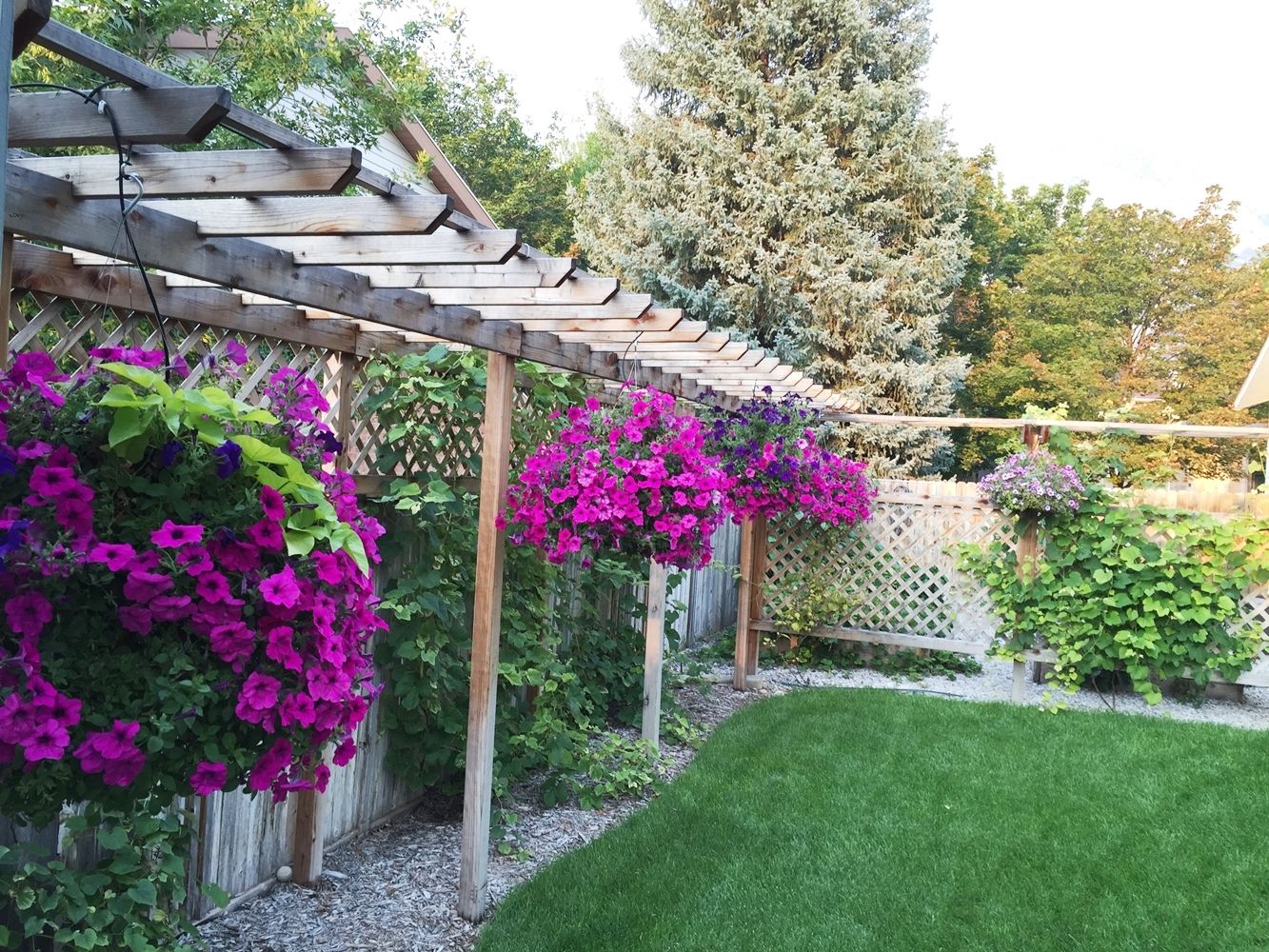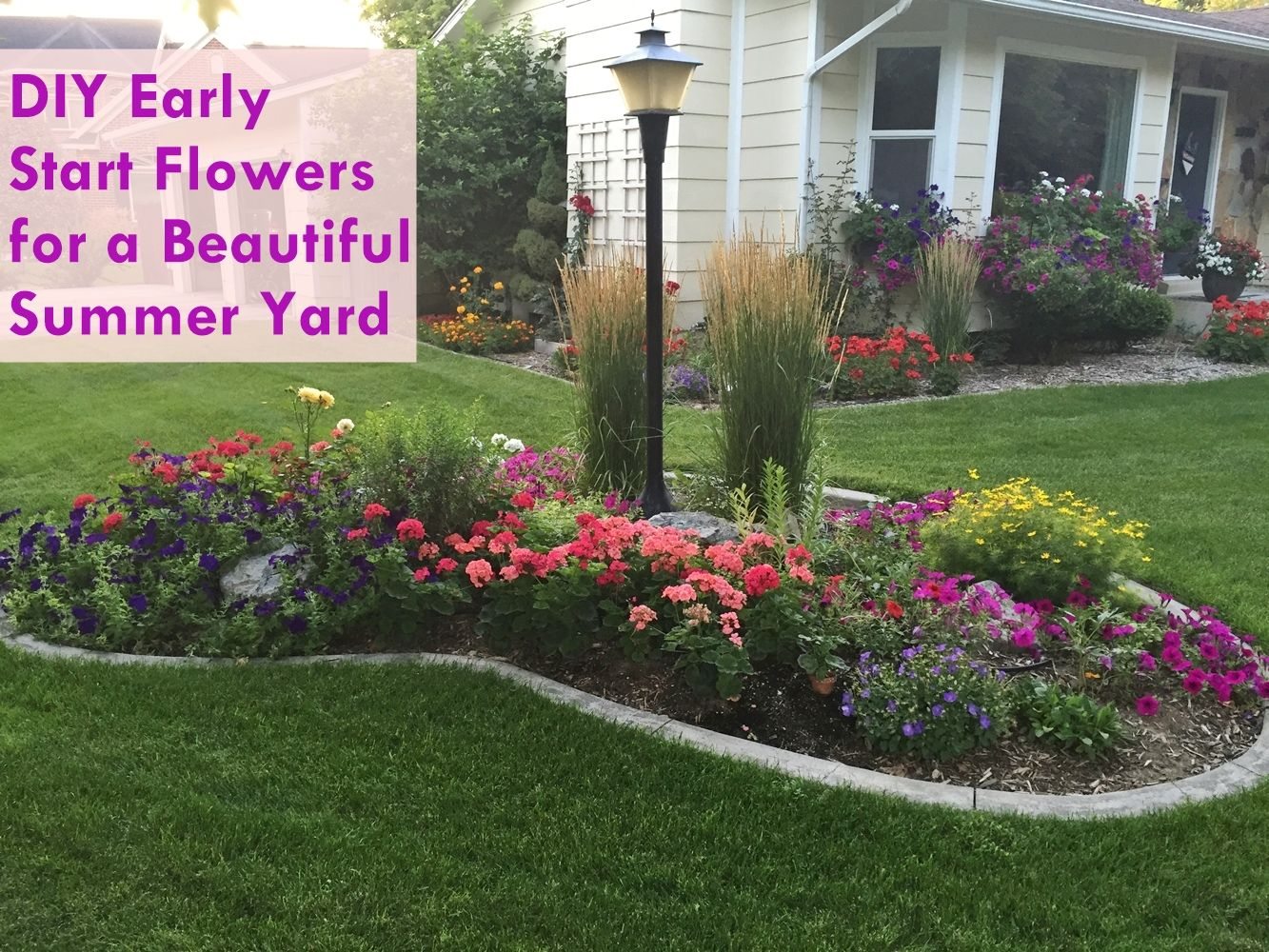DIY Early Start Flowers for Flower Boxes
Do you love flowers? With spring here and summer approaching, do you wish you had more flowers in your life, in your yard, in your landscape? It can be expensive to outfit your entire yard with the blooms of your dreams each spring. Although it takes more time and attention, it’s less expensive to buy flower seeds and give them an early start in late winter.
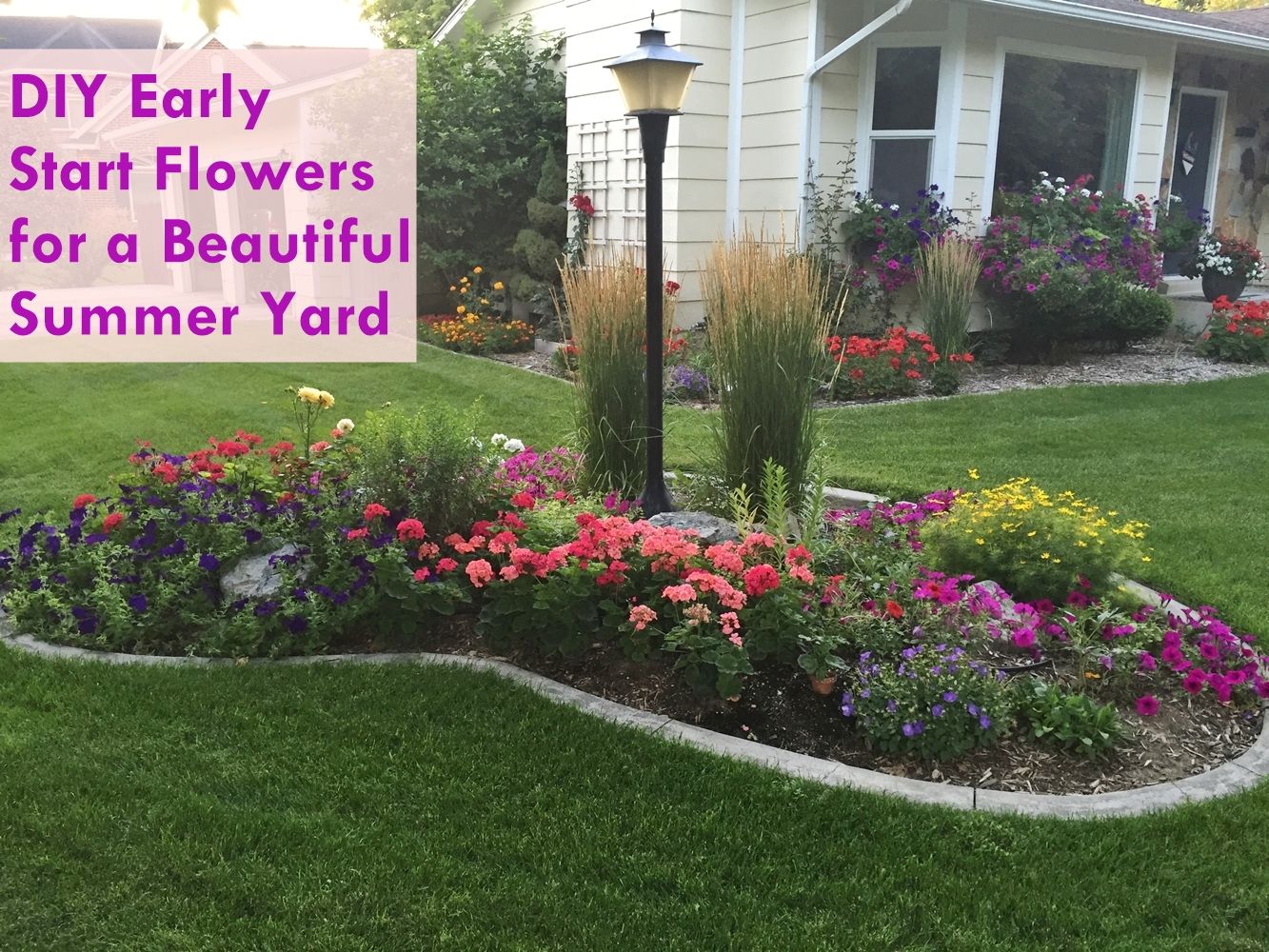
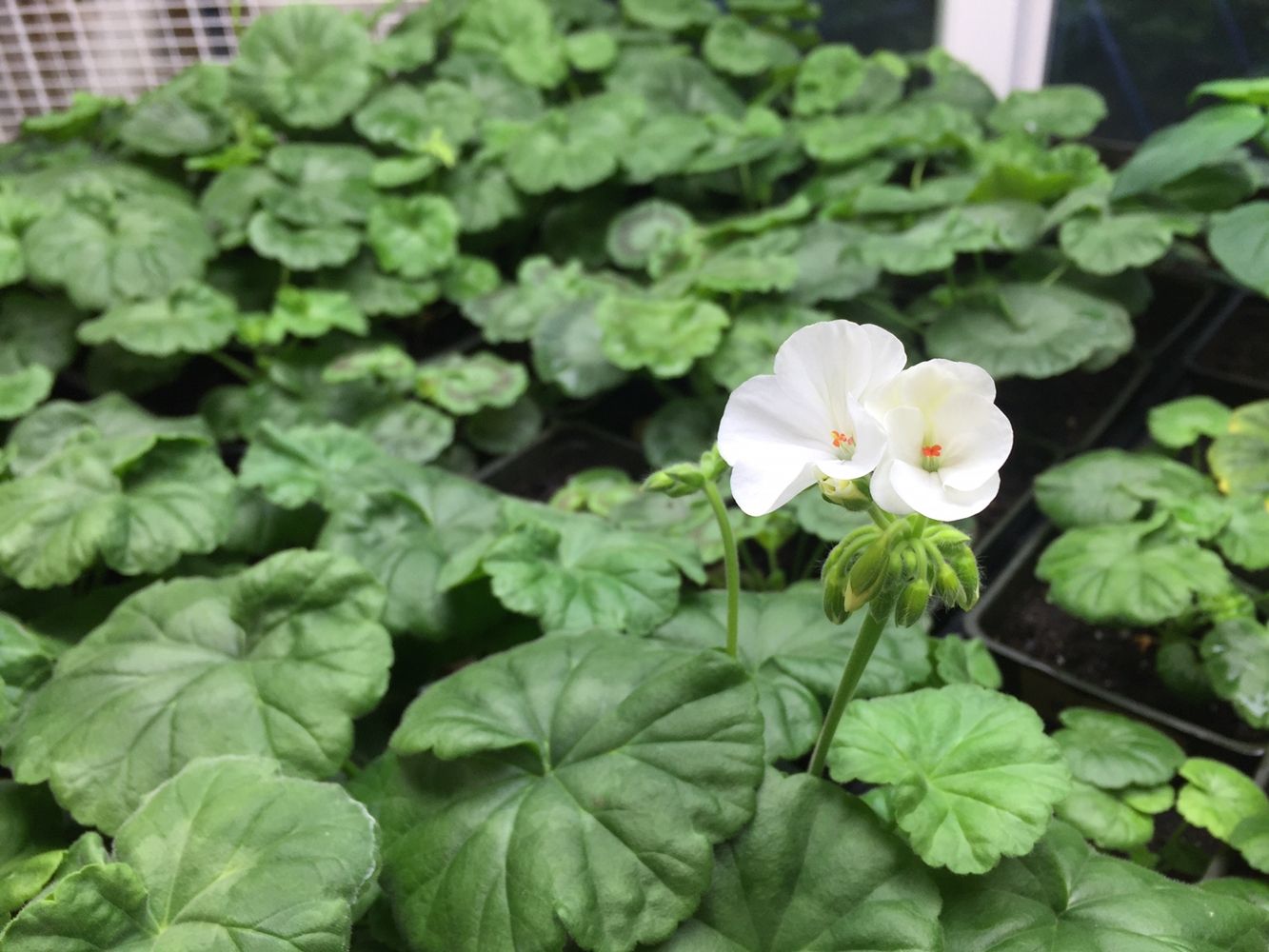
Grow them under your grow lights, and you’ll be ready to transplant them into your flower boxes or yard for beautiful blooms in spring. Sound easy enough?
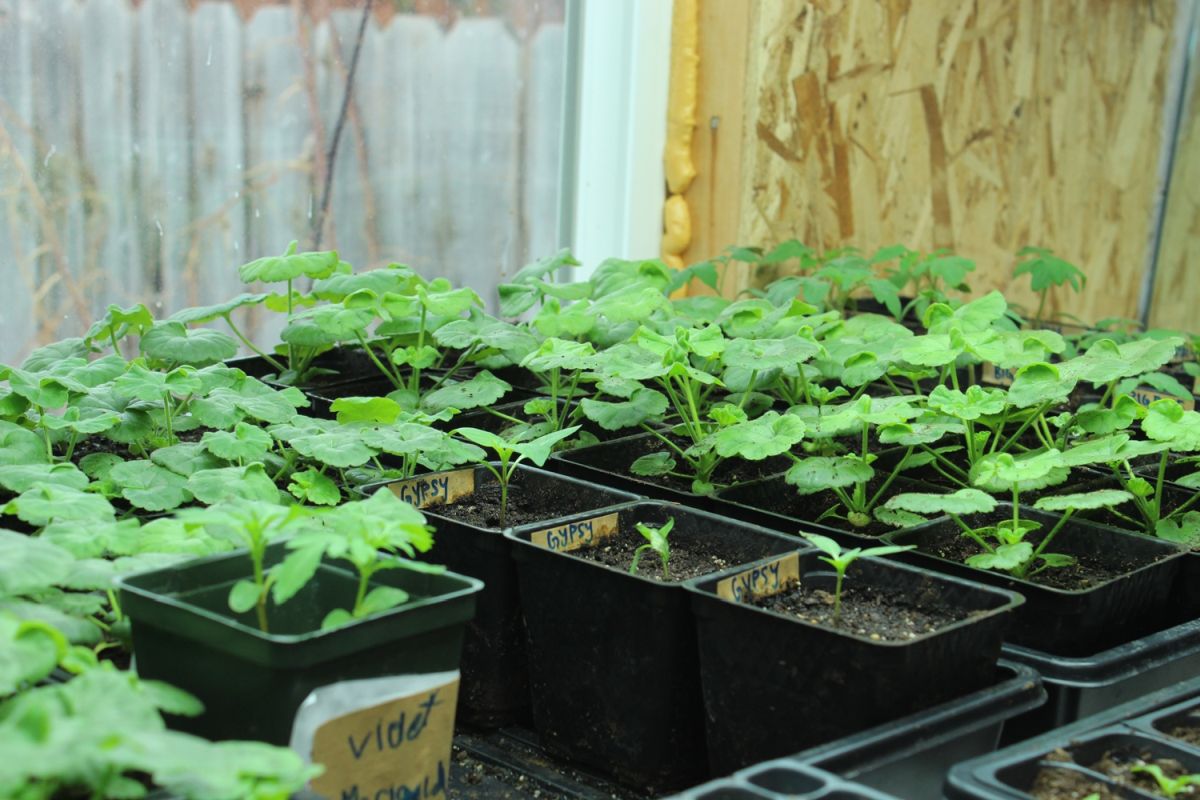
The thing is, there are some tips and tricks to make this process easier and more successful. We’ll take you step-by-step through the important stages in this article to help you give your starts maximum chance for thriving.
Transplanting Seedlings to Larger Potting Containers
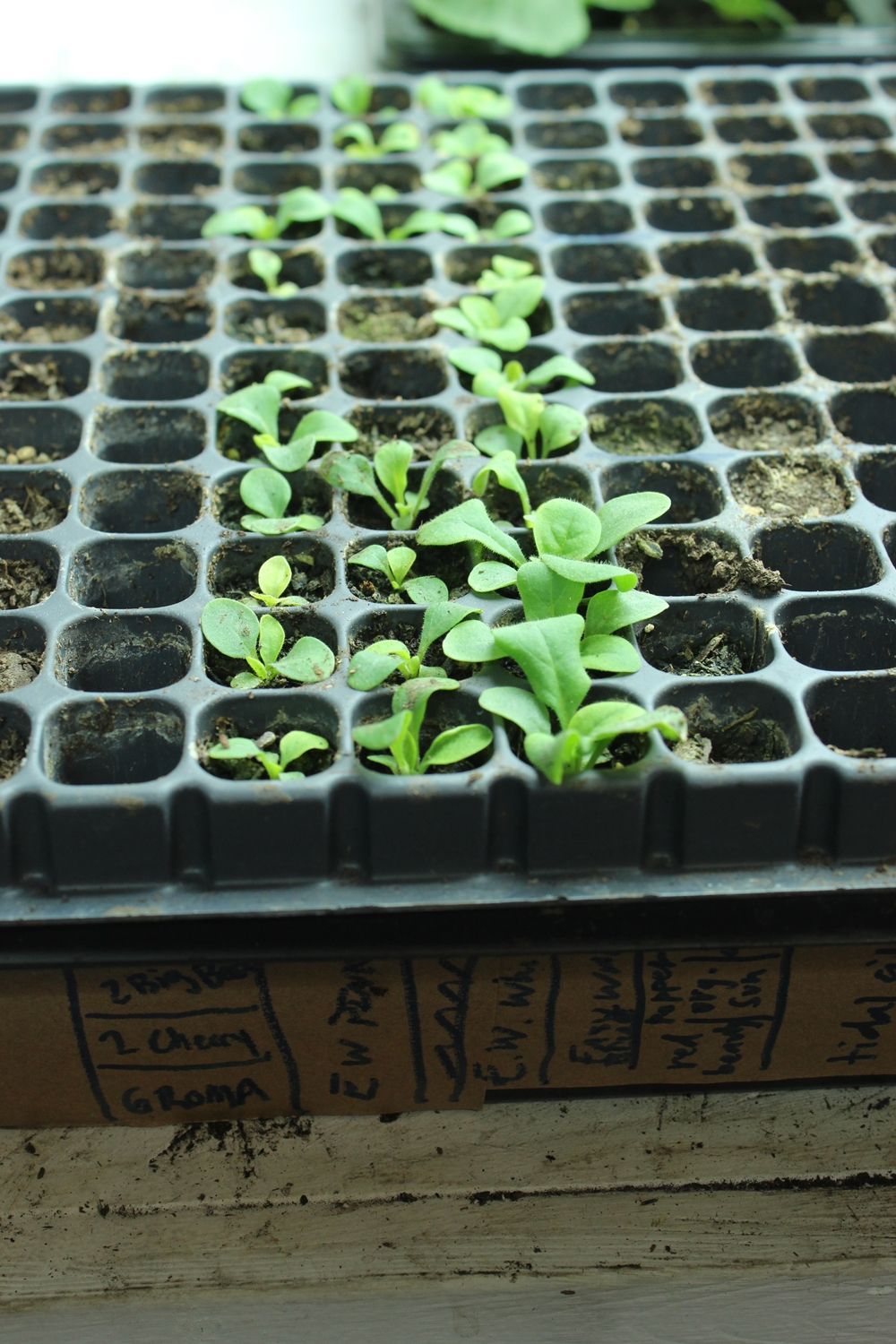
We walked you through planting your flower seeds in our article on installing your grow lights and getting started on planting. You might find it helpful to review that article. Assuming you’ve planted your seeds, have been watering and lighting them daily, you’ve likely seen some growth. Maybe too much growth? It can seem that way.
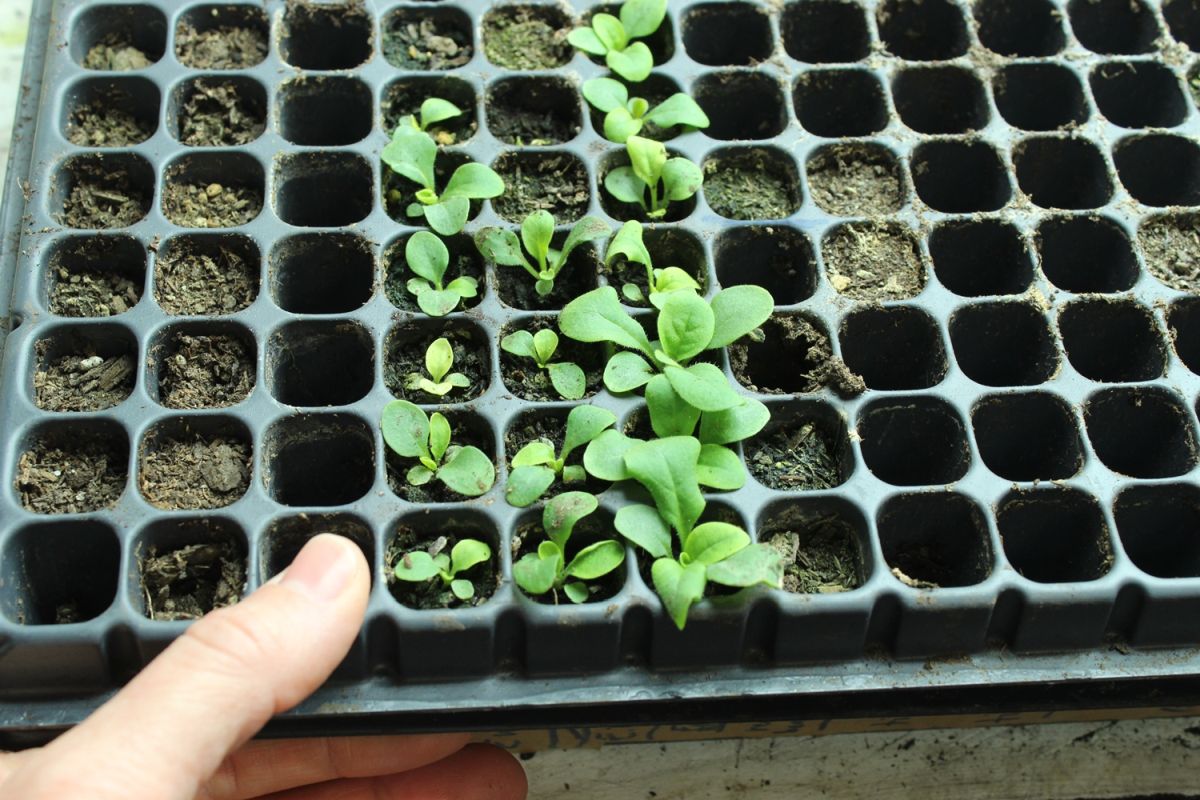
It’s not too much growth, though. It’s perfect! When the leaves of your plants start to extend past the edges of their individual potting containers, that’s a good indication it’s time to size up.
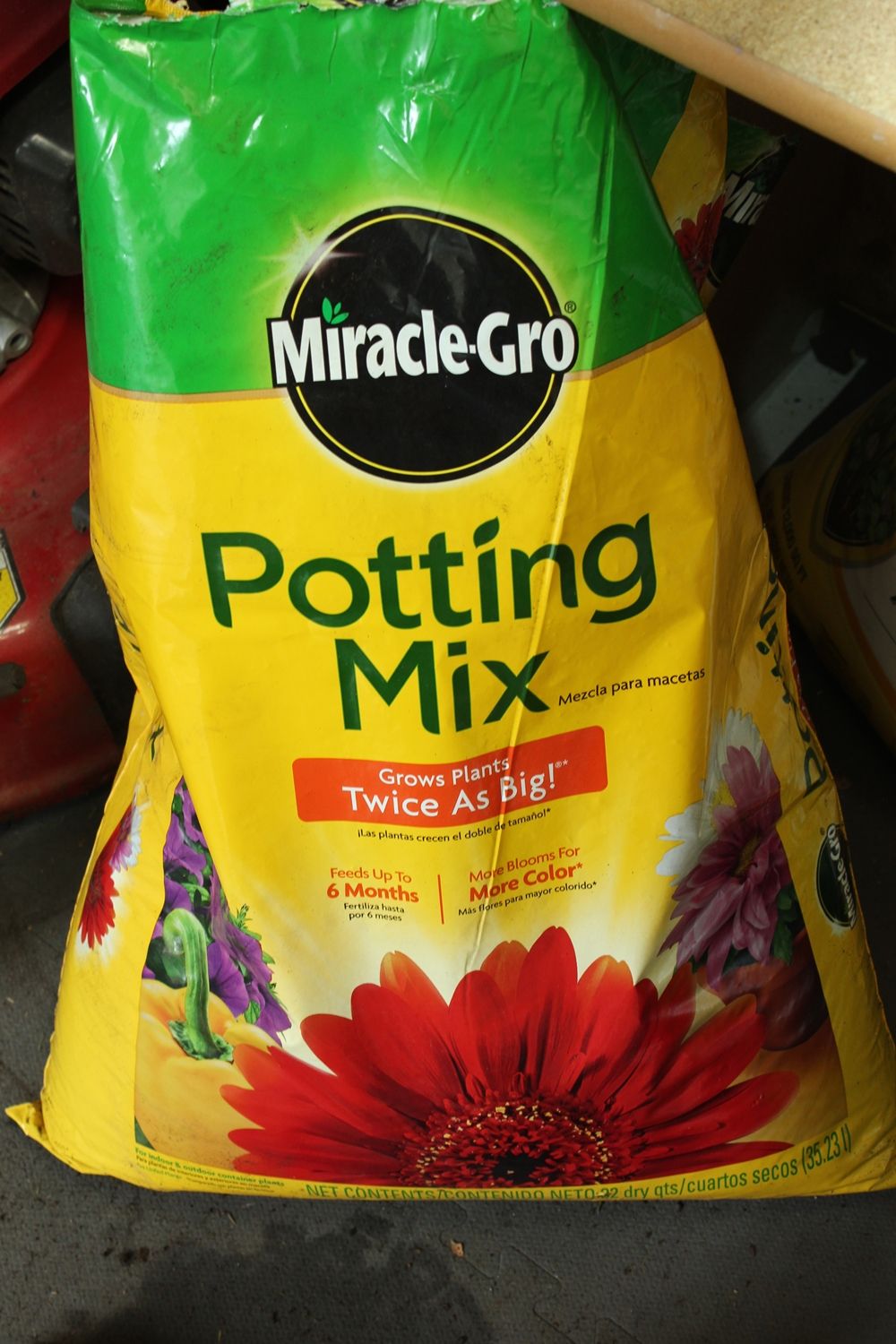
Prepare a flat of the next size of seed germination containers. If you’re moving up from the tiniest seed start size, you’ll be working with a flat of twelve (12) four-pack containers. Fill the new, larger containers with potting soil or potting mix.

Create holes in the center of each container that are roughly the size of the old, small containers. In this case, the holes are just the size of the seed start plugs.

Tip: If the hole stays in your soil, you’re good to go. If the soil caves in around the hole as you remove your fingers, you’ll want to dampen the soil so it keeps its shape.
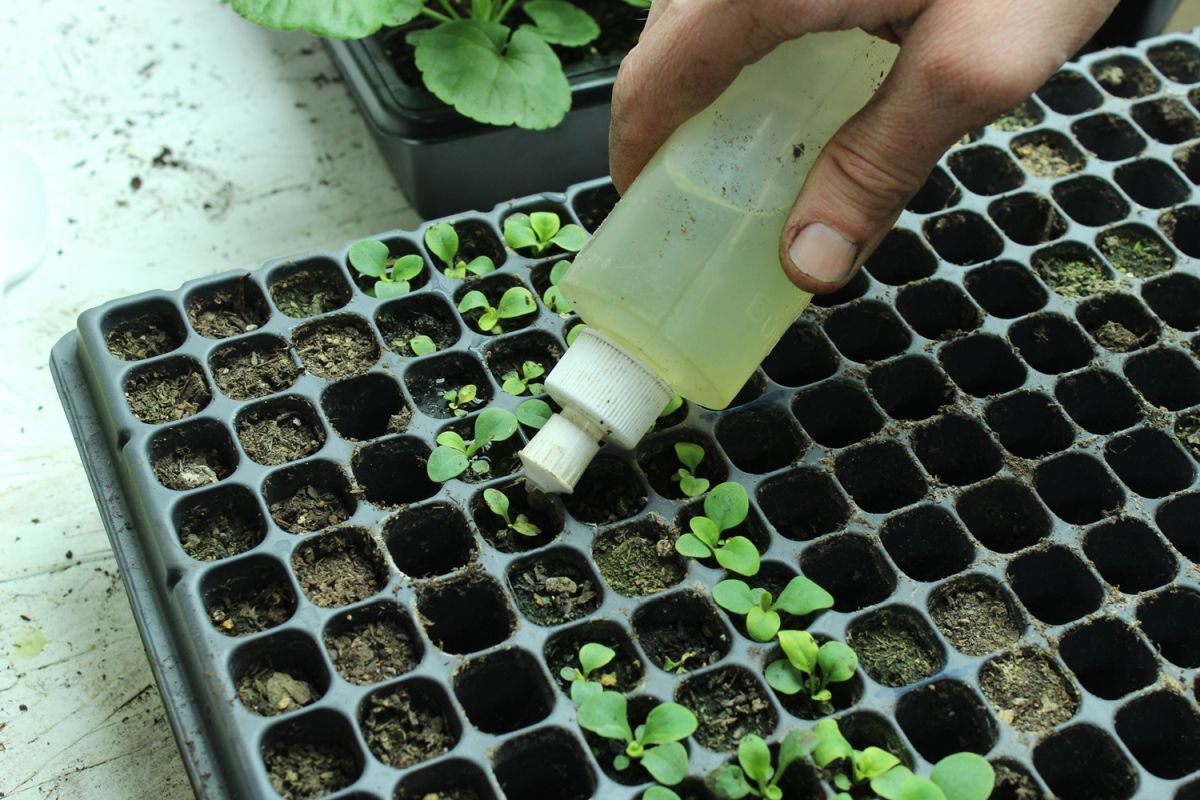
Dampen the soil around the plant starts to be transplanted. You want the soil just moist enough that it holds its shape, but not so wet that it’s heavy and falls apart.
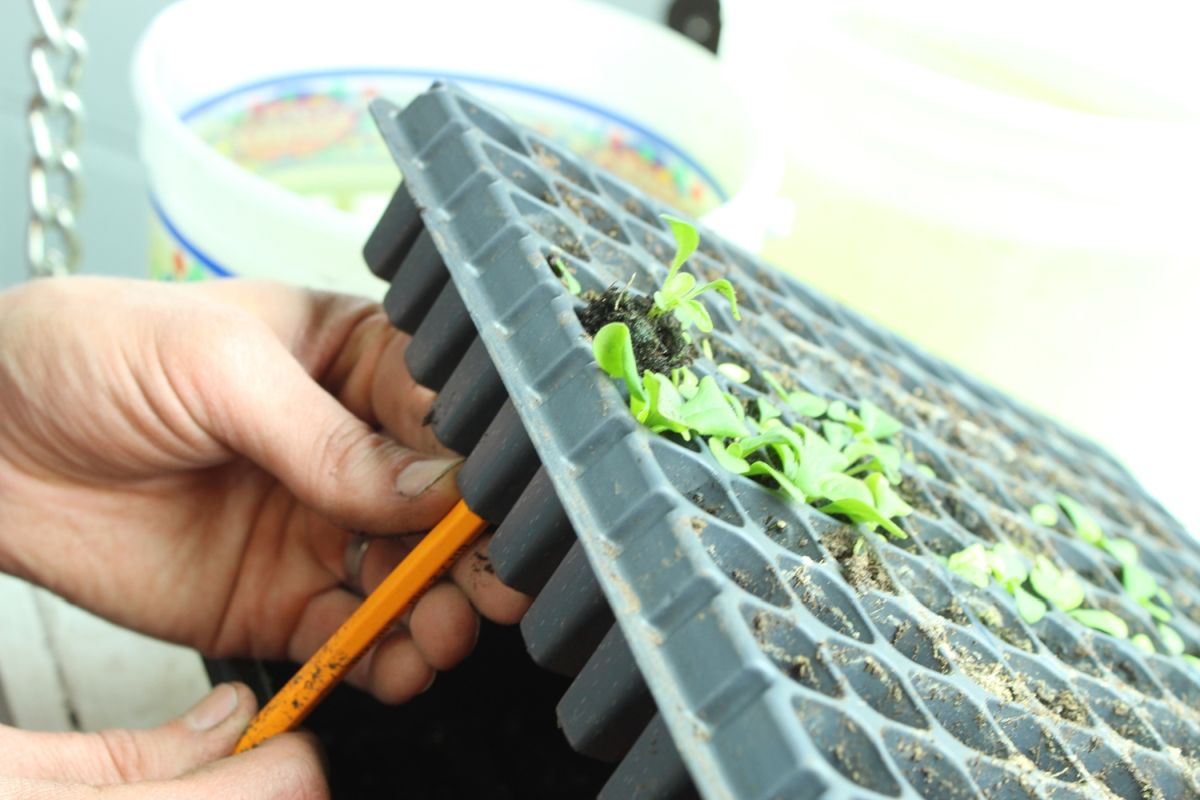
Carefully use your finger or a pencil to push up one of the plugs to be transplanted.
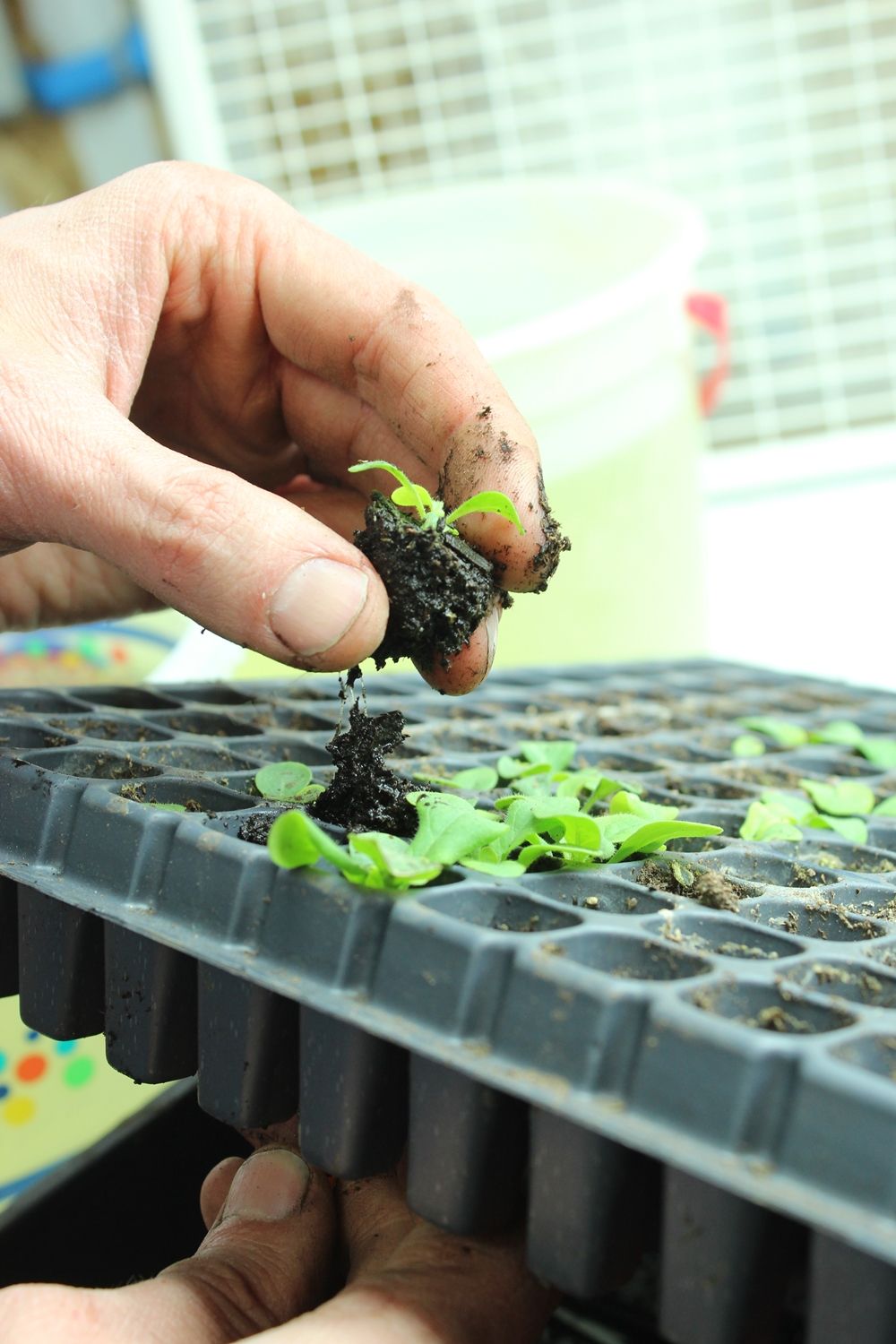
(This is easiest with a partner, but doable on your own if necessary.) Gently grasp the soil plug and remove it from the tray.

Drop the plug into one of the holes you’ve created in your next-size-up seed germination containers.
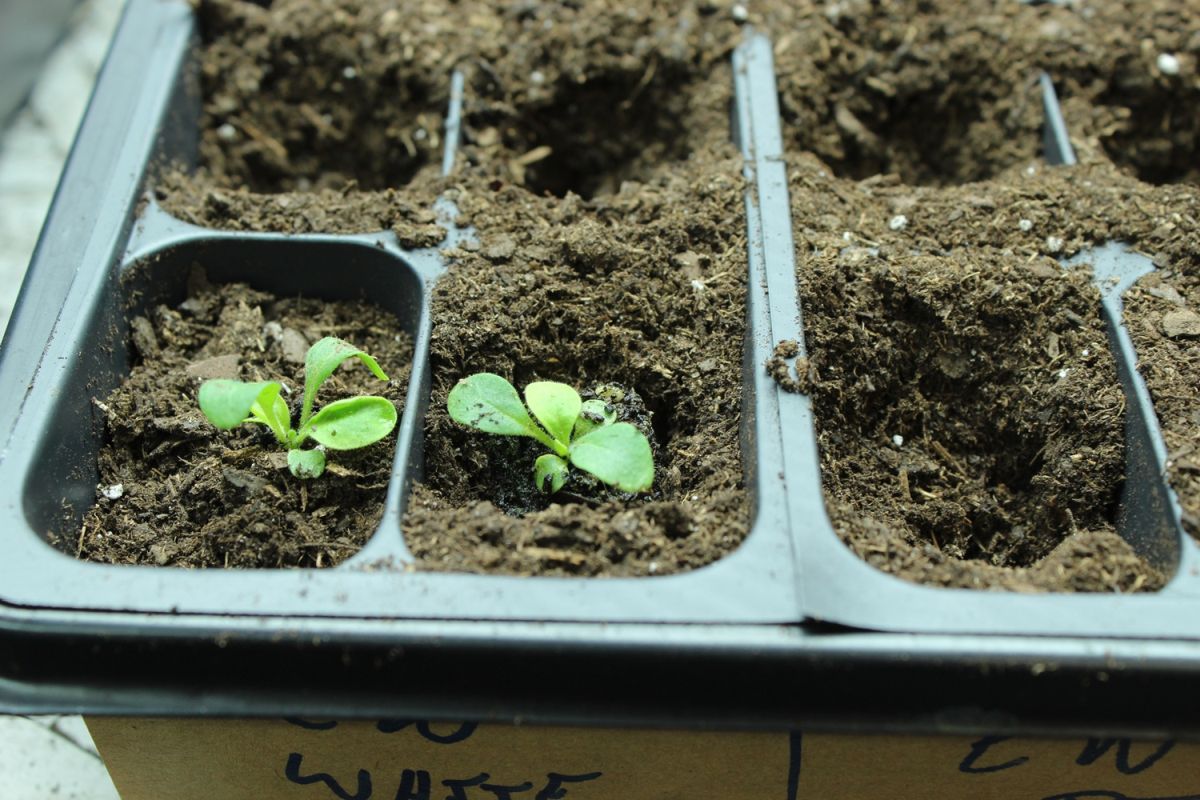
Taking care to keep the dirt from covering the early start leaves, fill in soil around the plug so the plant is at home in its new, larger space.
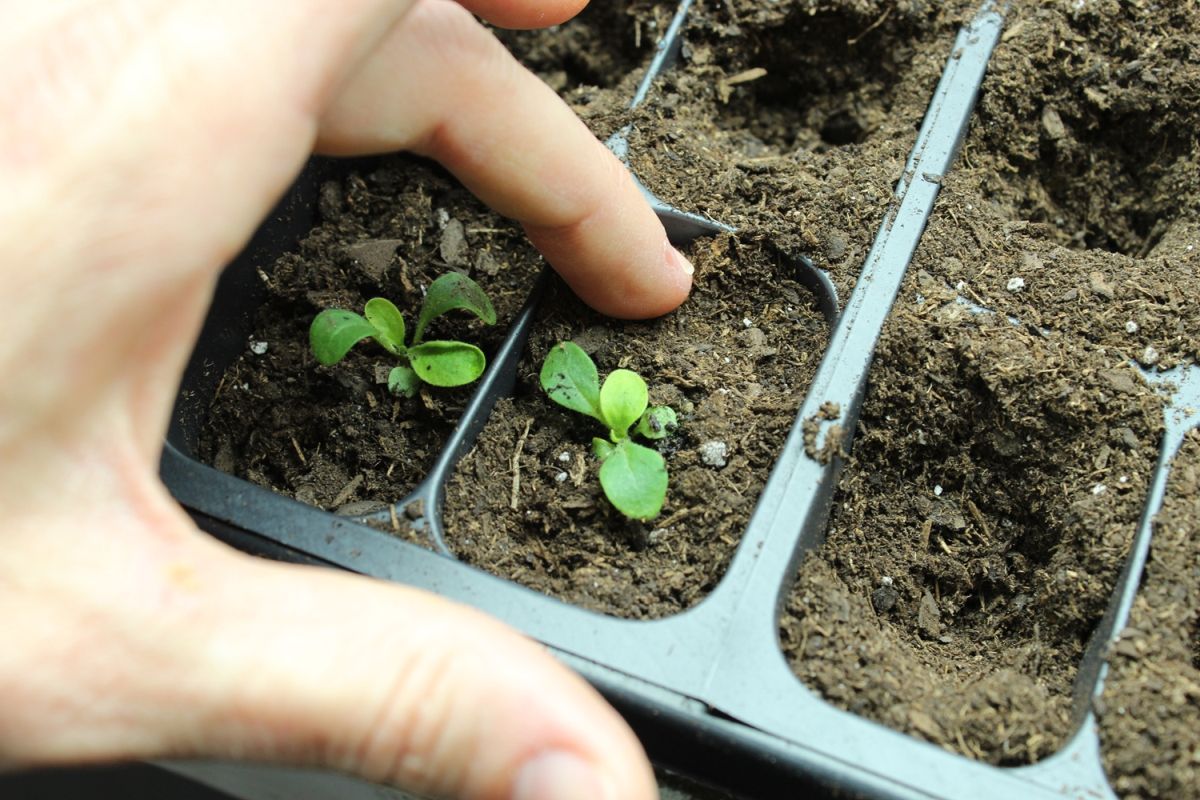
Repeat for other plugs of the same type/color of flower.
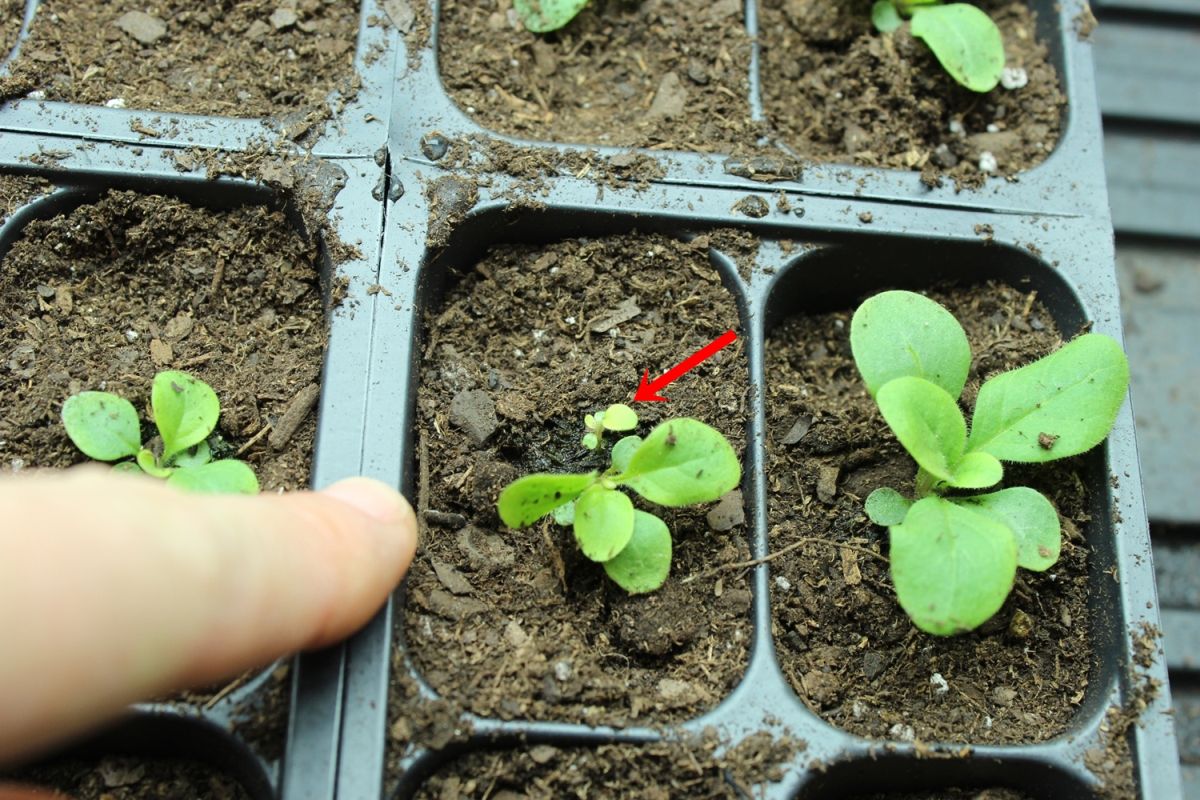
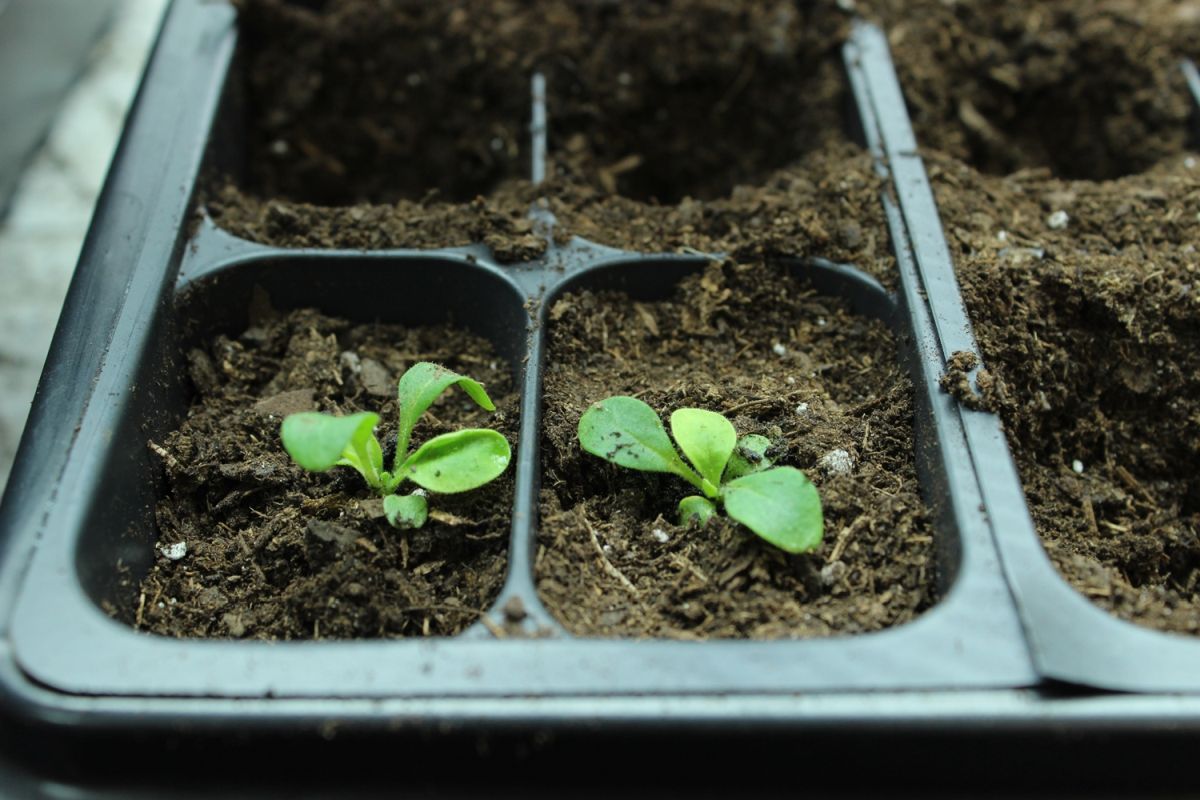
If you run into a double-start, or a plug that contains two starts, you’ll need to choose the healthiest looking one to keep and cut the other.
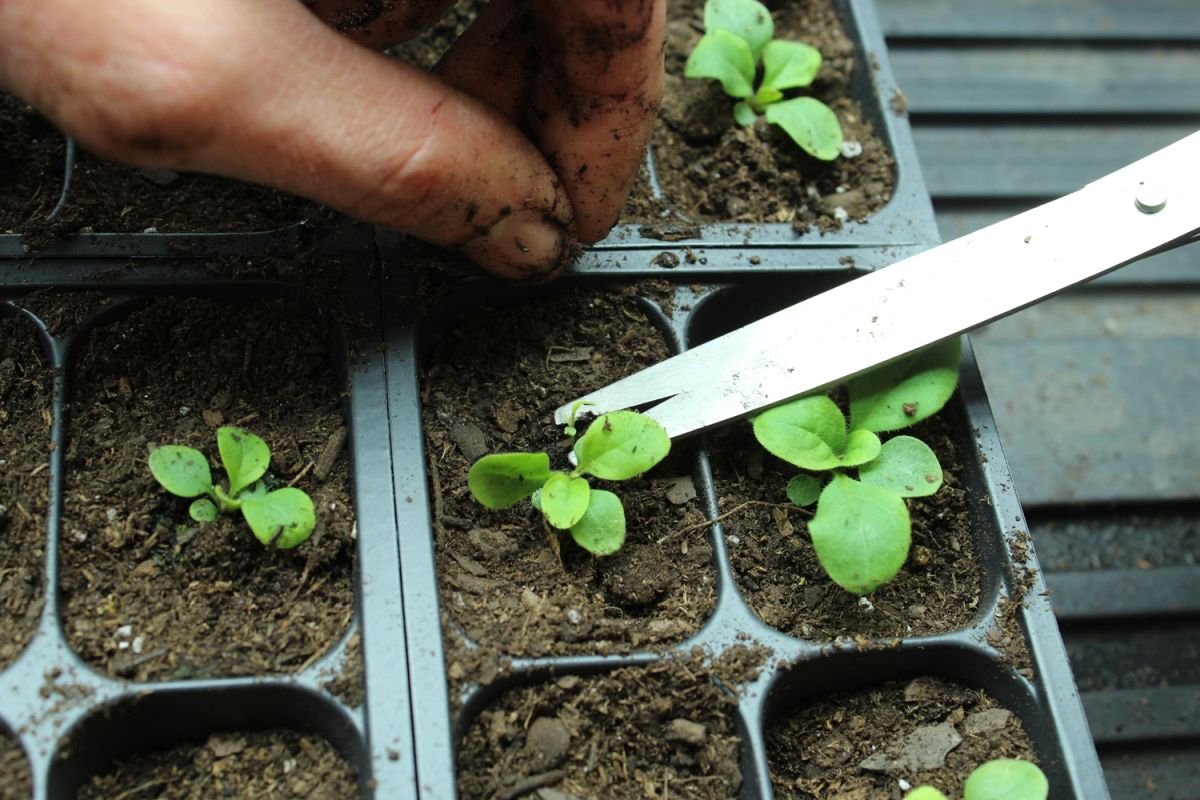
Take some sharp garden scissors, and snip off the weaker start at its base. Don’t try to pull it out. The roots will die off on their own.
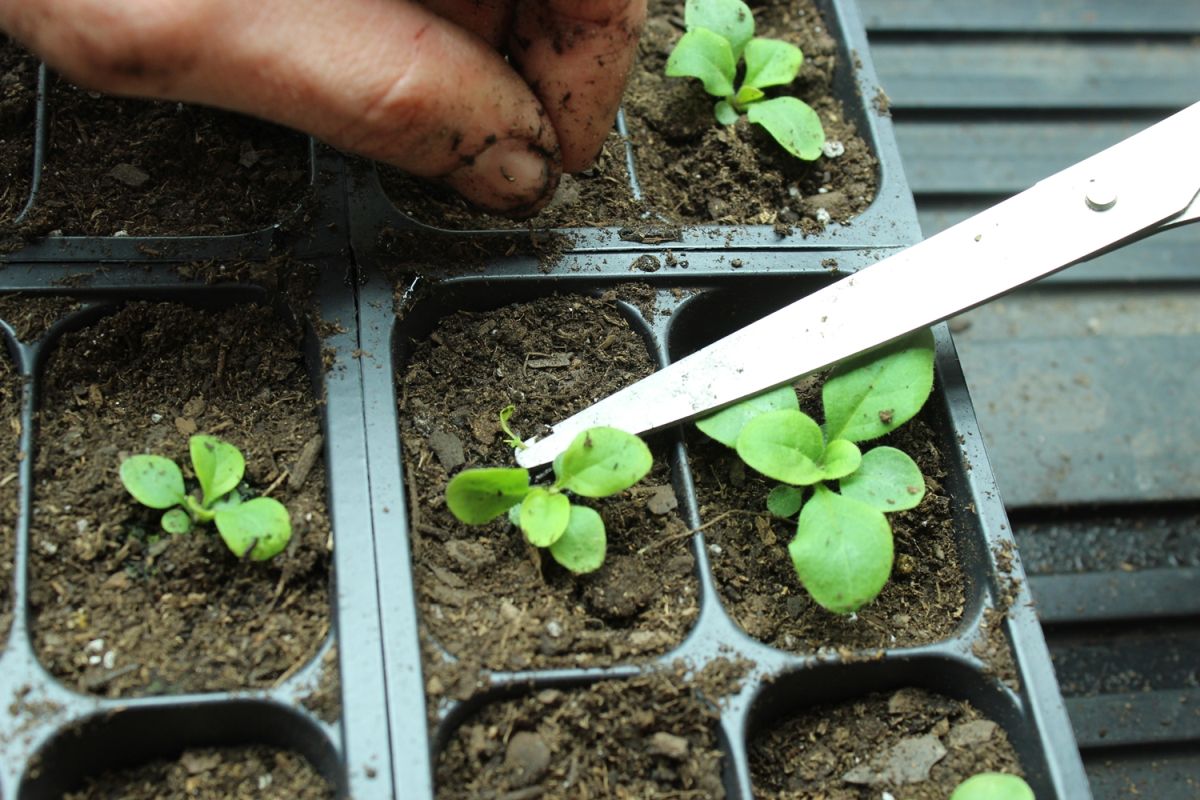
While this may be hard to do, emotionally (it can be surprising how much people can get attached to these little plantlings!), it’s critical. If you let both keep growing, they will choke each other out, and they’ll both die.
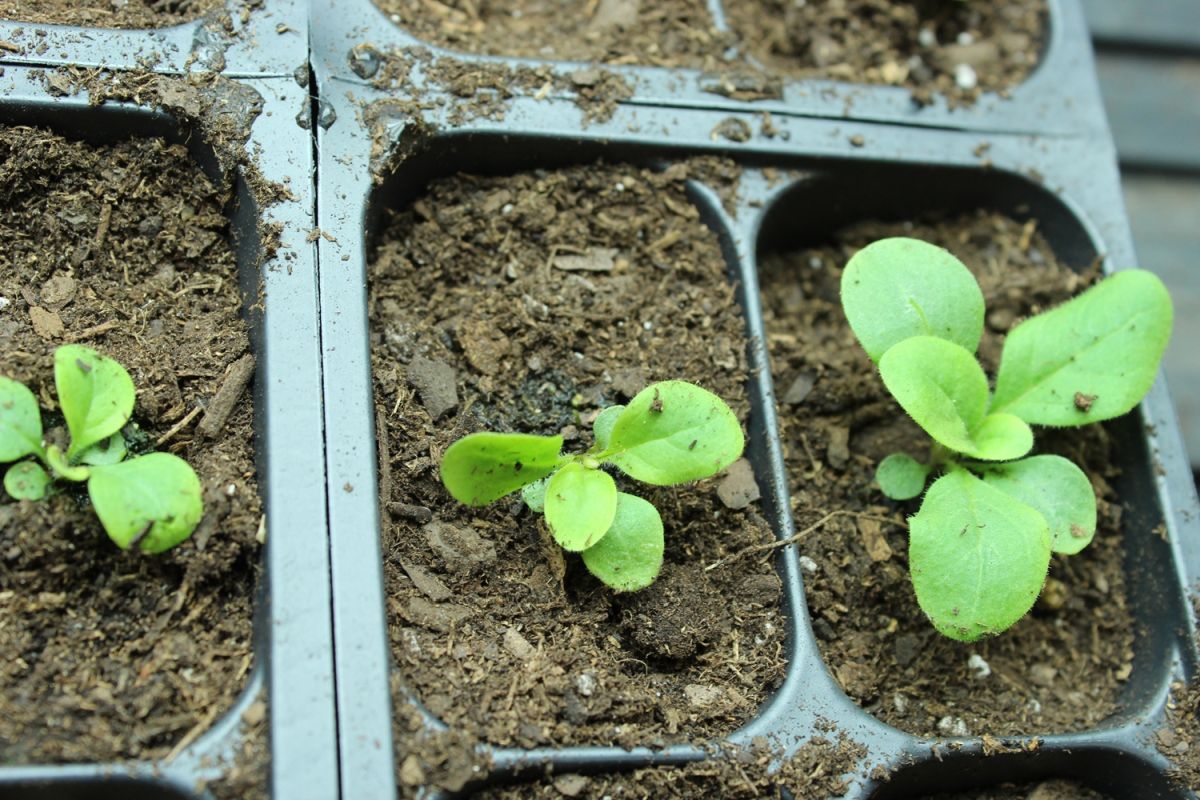
If you try to pull one of the plants out instead of snip it, the roots might be intertwined with the healthier start’s roots, so both root systems could be compromised. It’s best – and necessary – to simply snip one.

Carefully label the type and color of flower, and where they’re planted, before moving on to the next type or color. I promise, you’ll be glad you didn’t try to remember as you go. Just take a minute and label each group so you’re not surprised come blooming time that a random blue ended up amidst the yellows. (Unless you don’t care, then by all means forgo the labeling.)
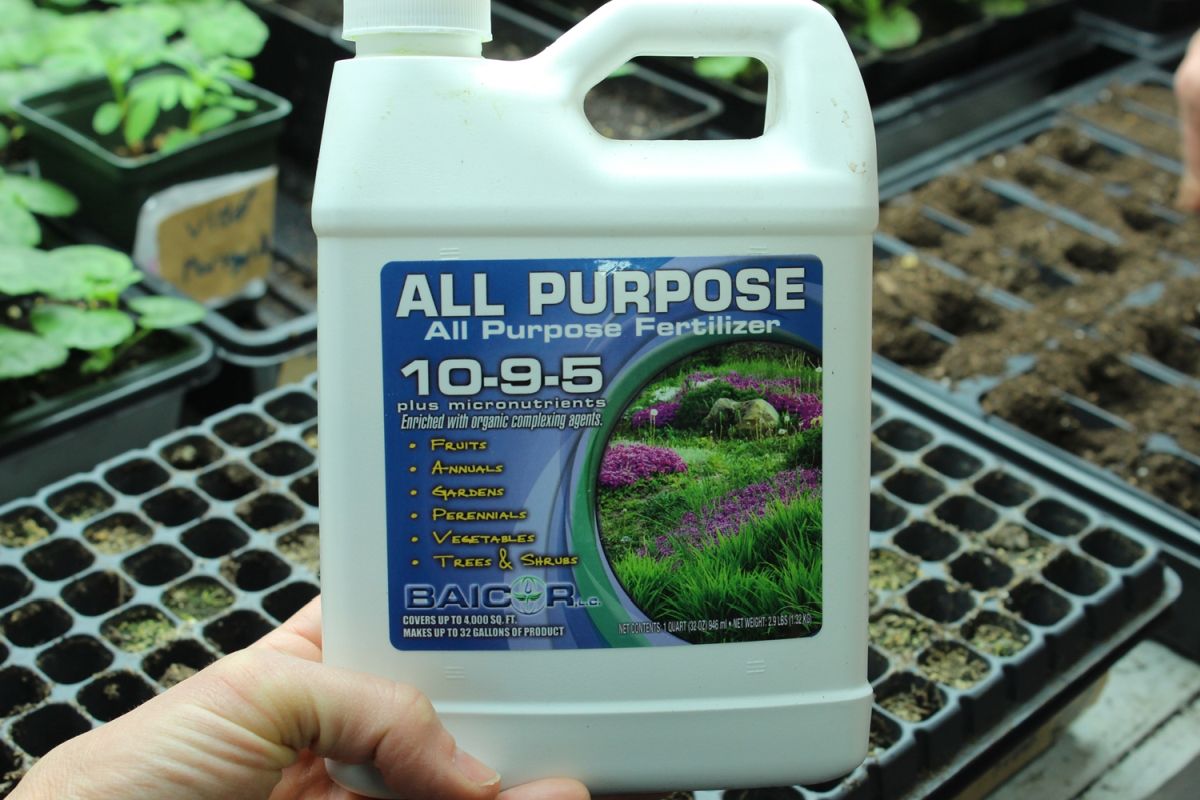
Mix, according to directions, a bucketful of liquid fertilizer into water.

After your flat is filled, fill a squeezy bottle with fertilizer water.
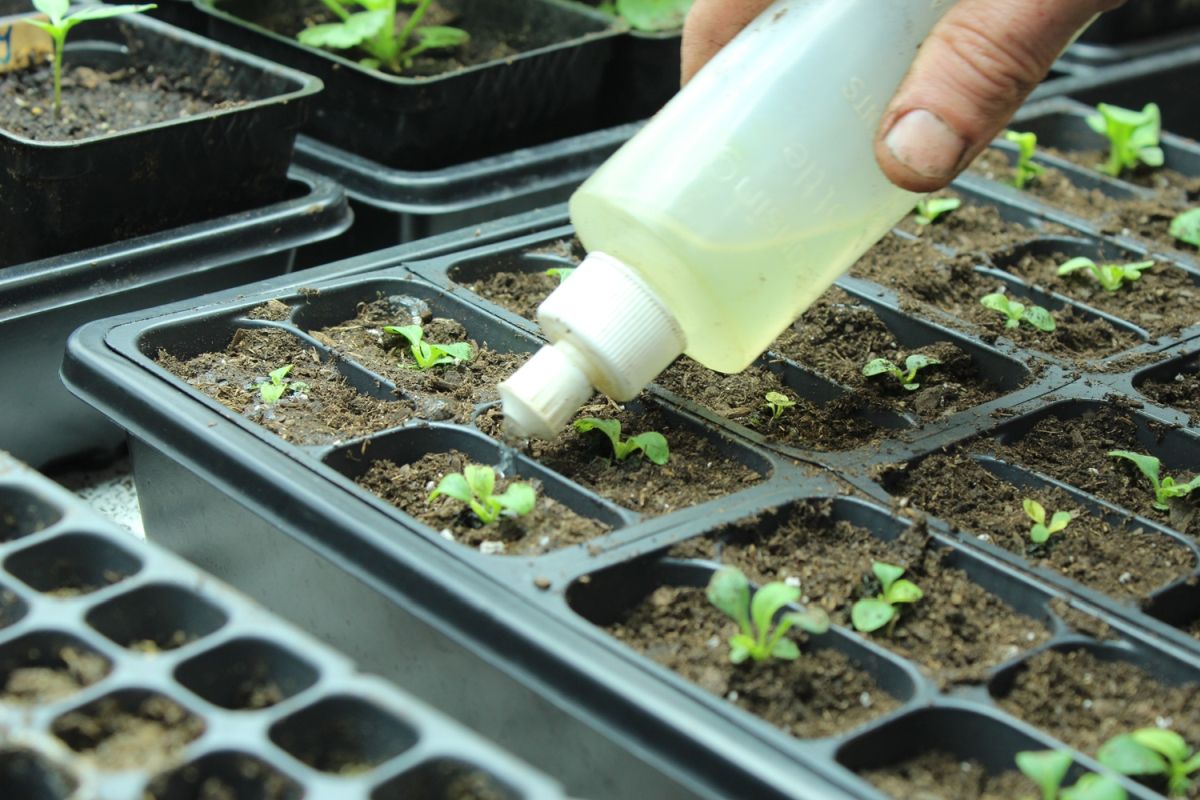
Give each start a good soak. This will help the transplanted soil integrate better into its new home soil, as well as give the shocked roots a little extra boost.
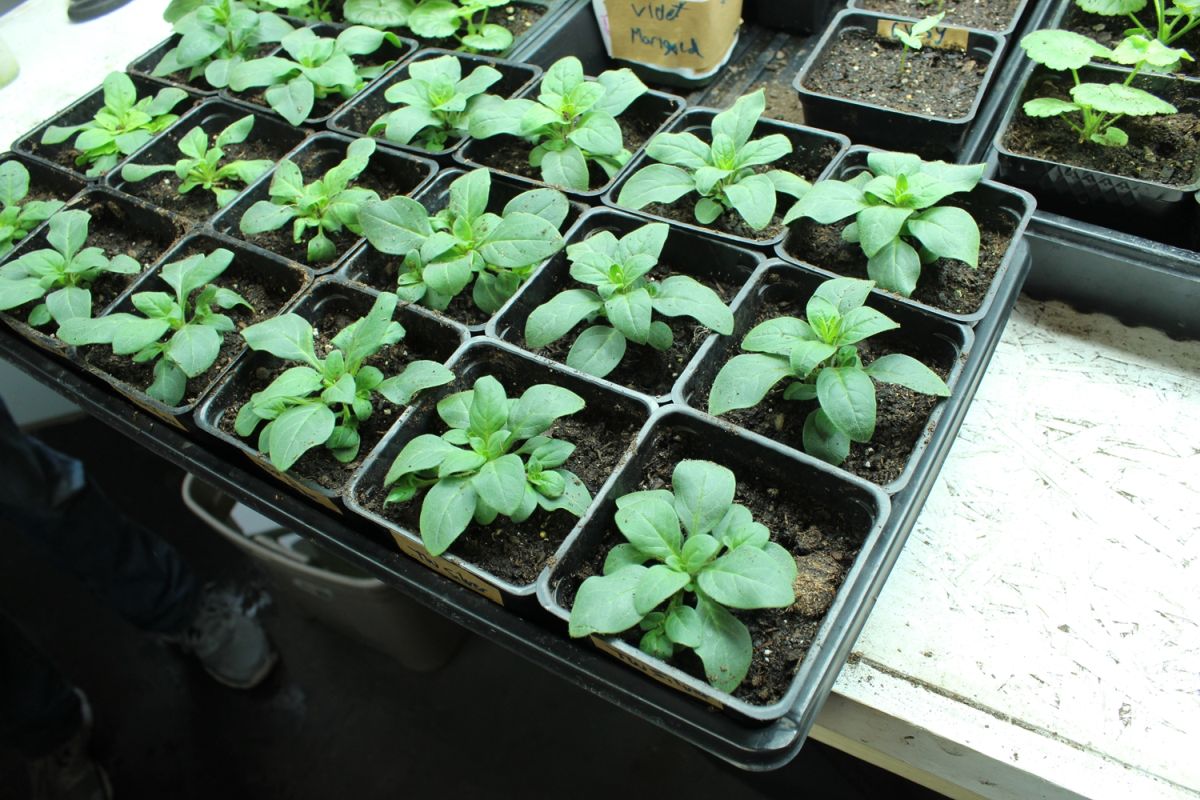
The next size up from a four-pack size of seed germination containers is probably the 4” square container. These petunias, with their large and growing leaves, were beginning to grow into each other’s spaces in their four-packs; they are much better proportioned in 4” pots.
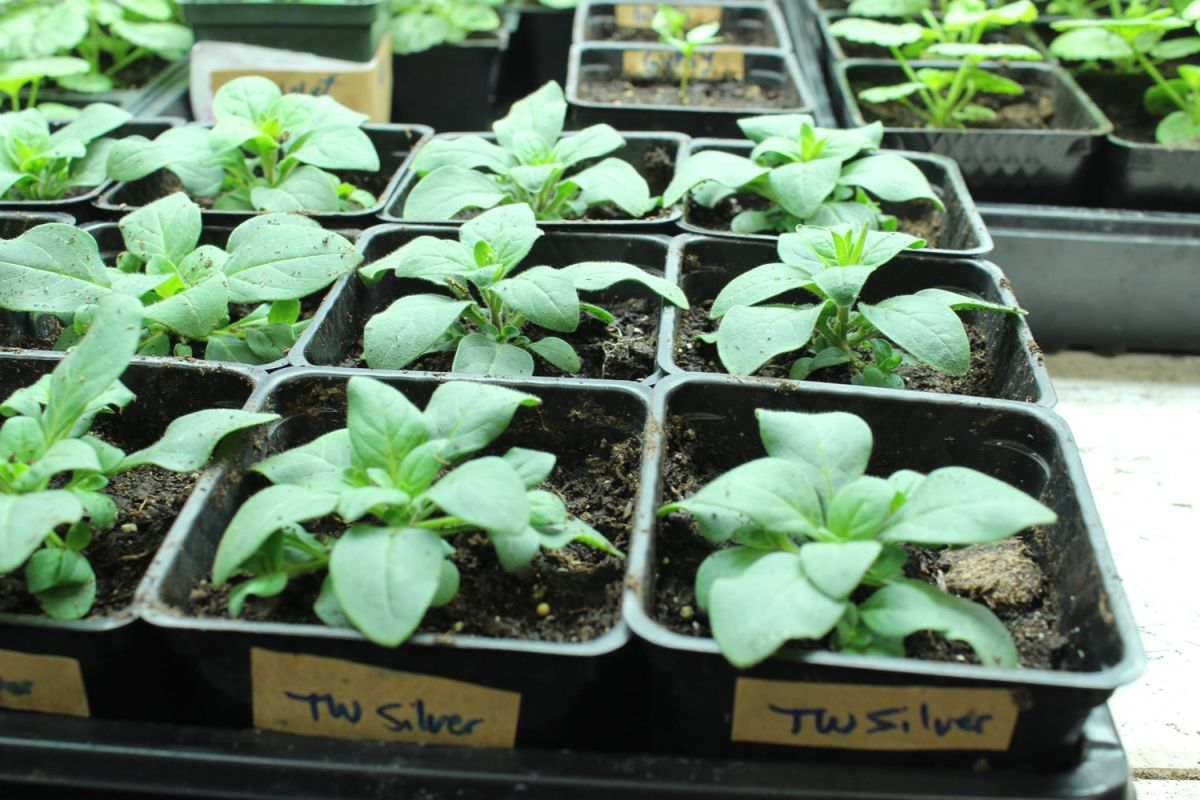
Even with the best soil, water, and light system, a plant’s growth will be thwarted (or stop altogether) if it lacks the space to grow.
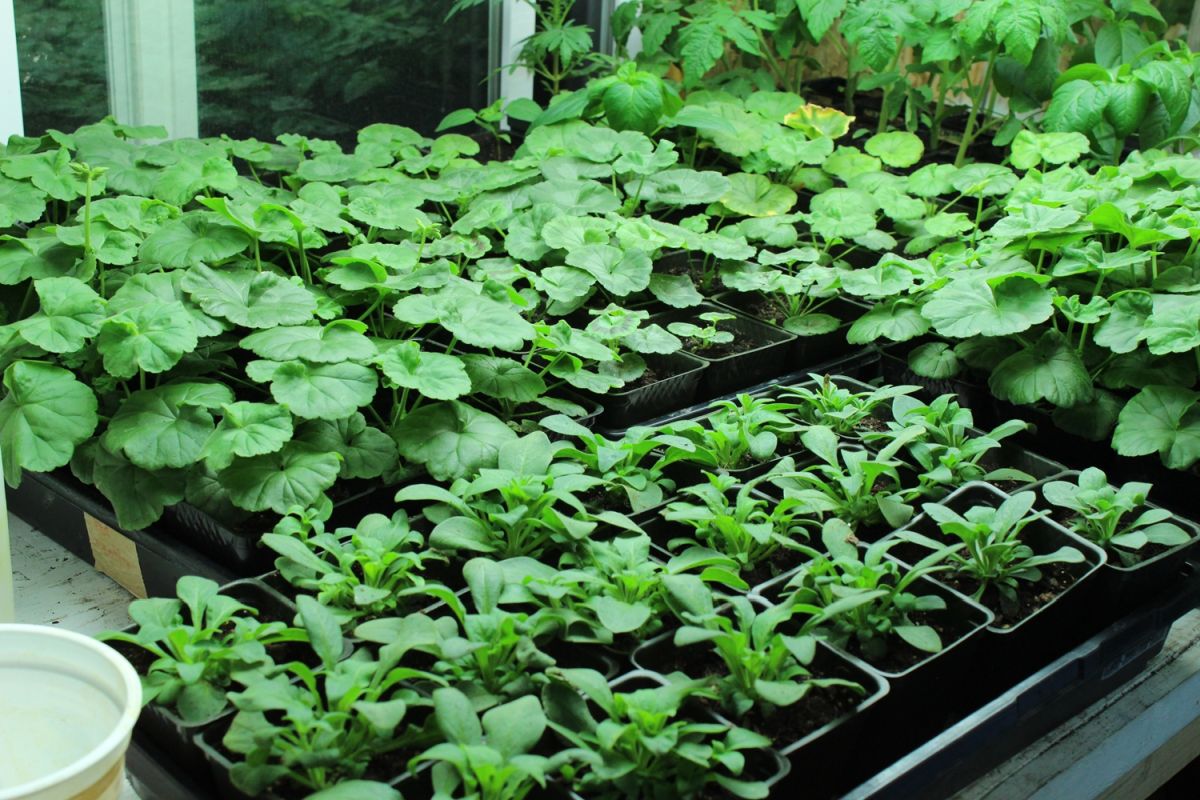
Although transplanting into the next-size-up for just a few weeks before outside planting might seem like a lot of extra work, it’s actually what will keep your little seed starts alive and well. Tip: It’s important not to go too big too soon, however, for several reasons: (1) it’s easier to store and manage smaller trays for as long as possible, (2) some seeds or starts will struggle or die, so it saves square footage to start small and identify and weed out the duds before upsizing, and (3) it saves water and soil to only fill a smaller appropriately-sized planting container, rather than having to water a huge pot every day for a tiny start.
Planting Petunia Cuttings
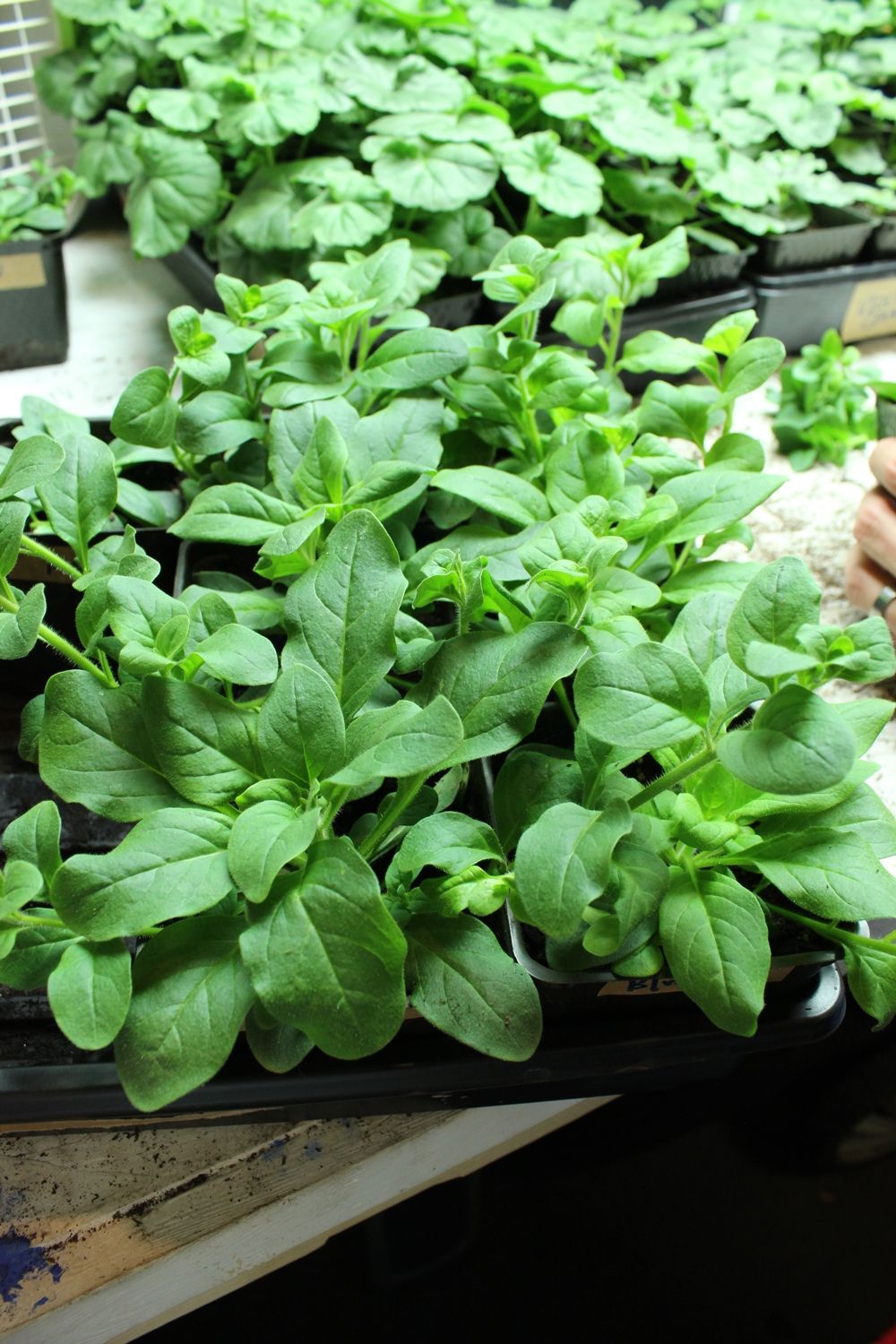
Some varieties of petunias are lovely plants with gorgeous blooms, but even the seeds can be expensive (easy wave and tidal wave petunias are examples). One way to cut your costs is to purchase fewer seeds then, when the plants are beginning to exceed their container boundaries, take cuttings and plant those.
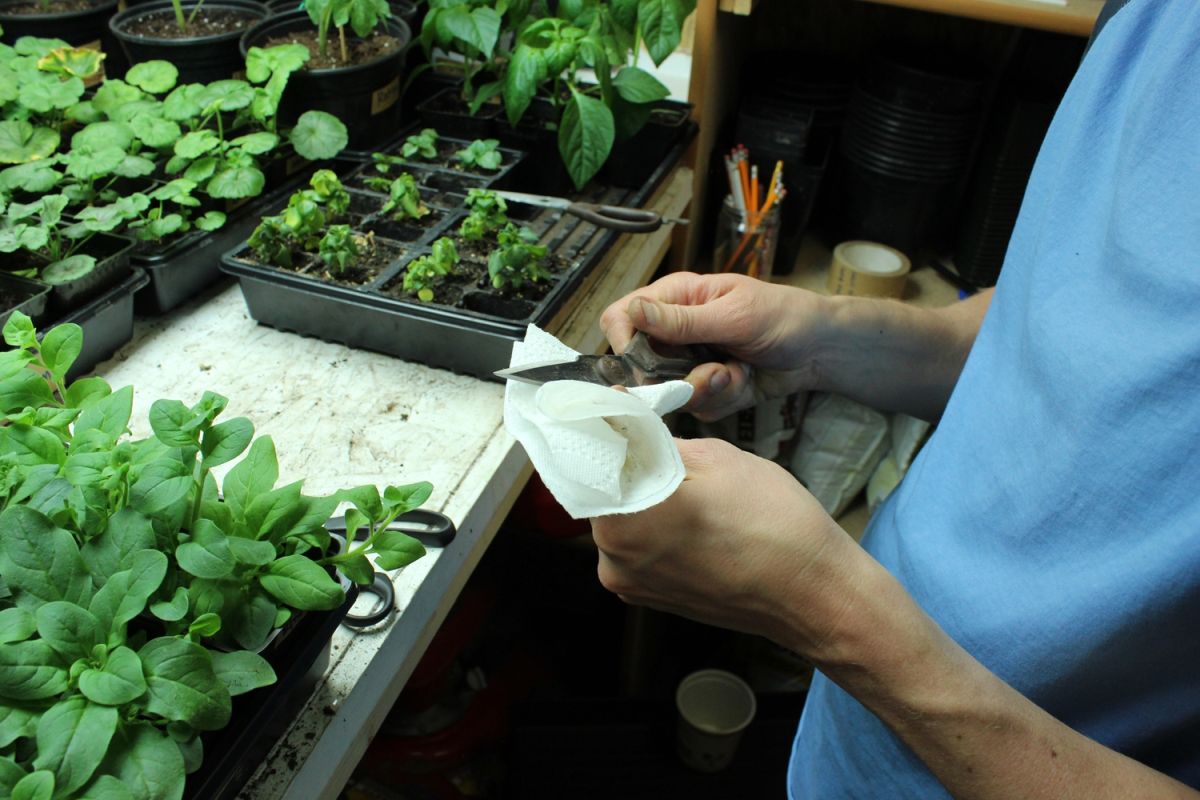
Begin by cleaning a sharp scissors blade. The sharper your scissors are, the better it will be for the plant.
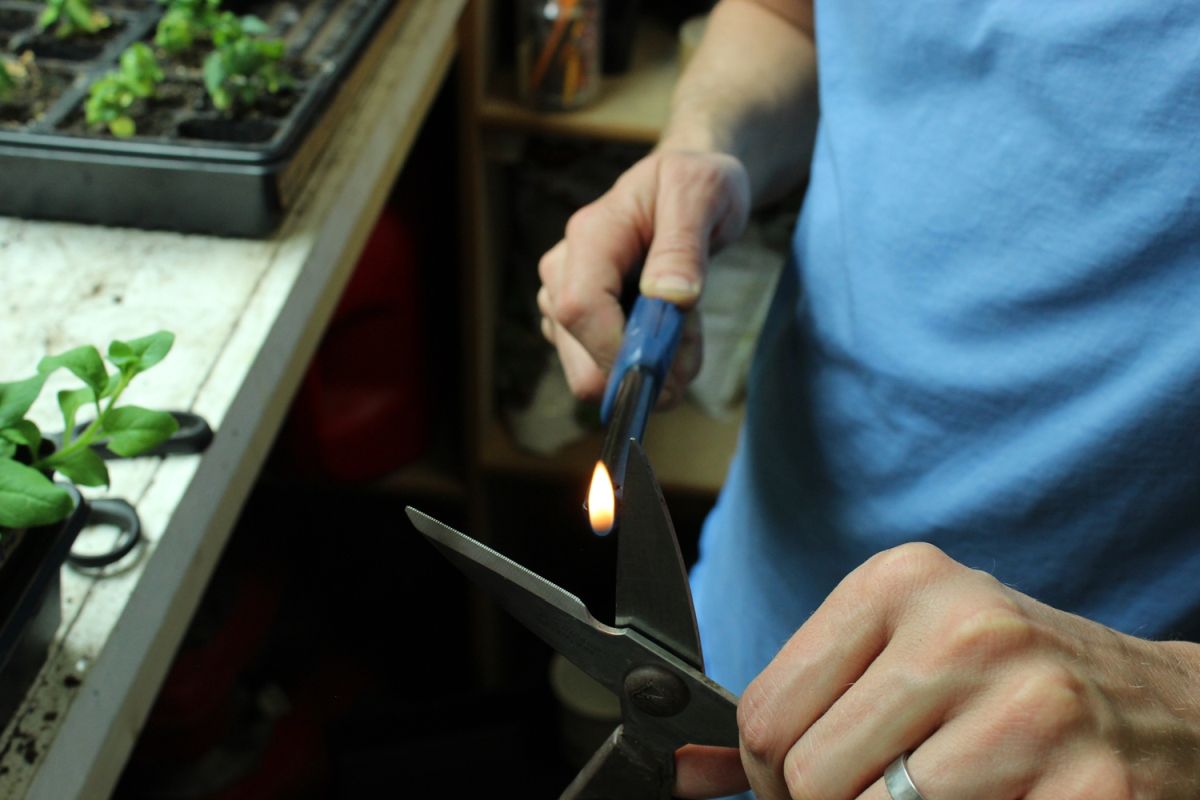
You can even go so far as to sterilize the scissors with a match or lighter. This decreases the chance of killing the plant with some odd germ or whatever on the scissors themselves.
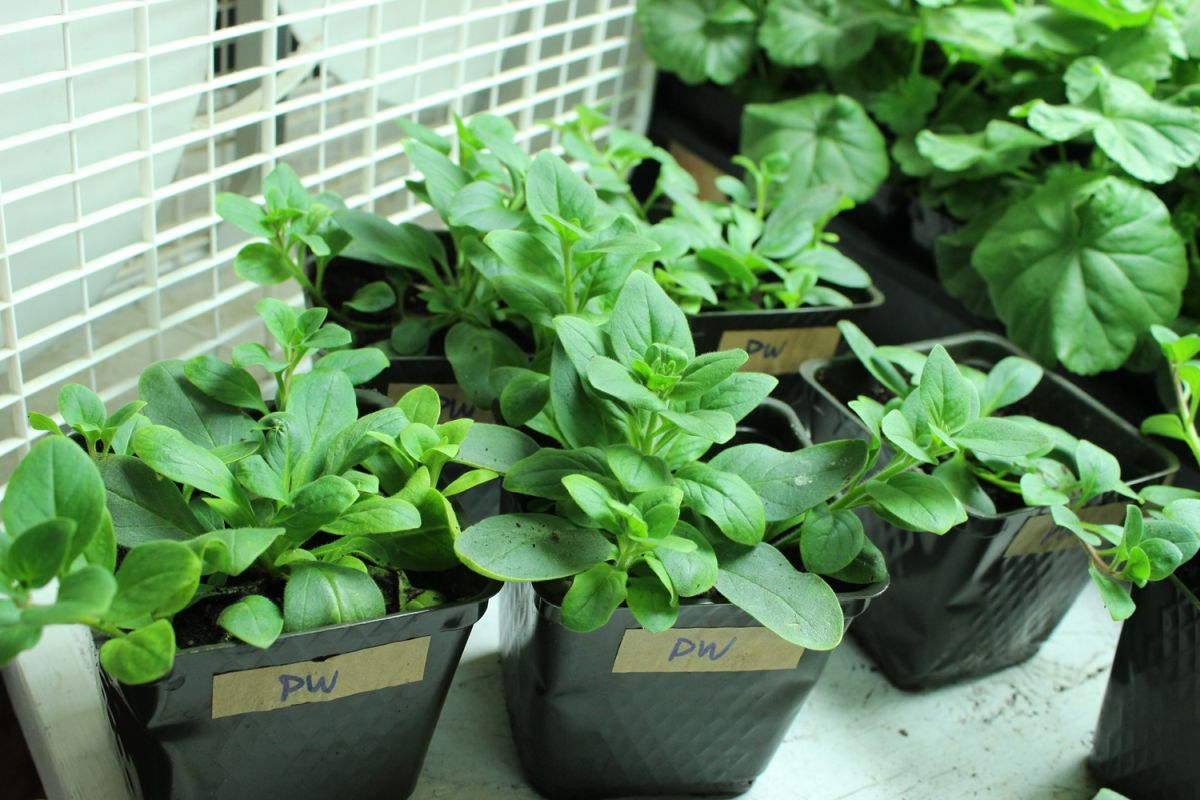
These petunias have “graduated” from the four-pack into 4” pots, and they have now exceeded their boundaries and are hindering nearby plants’ growth. So it’s time to trim them back…and benefit from replanting the cuttings.
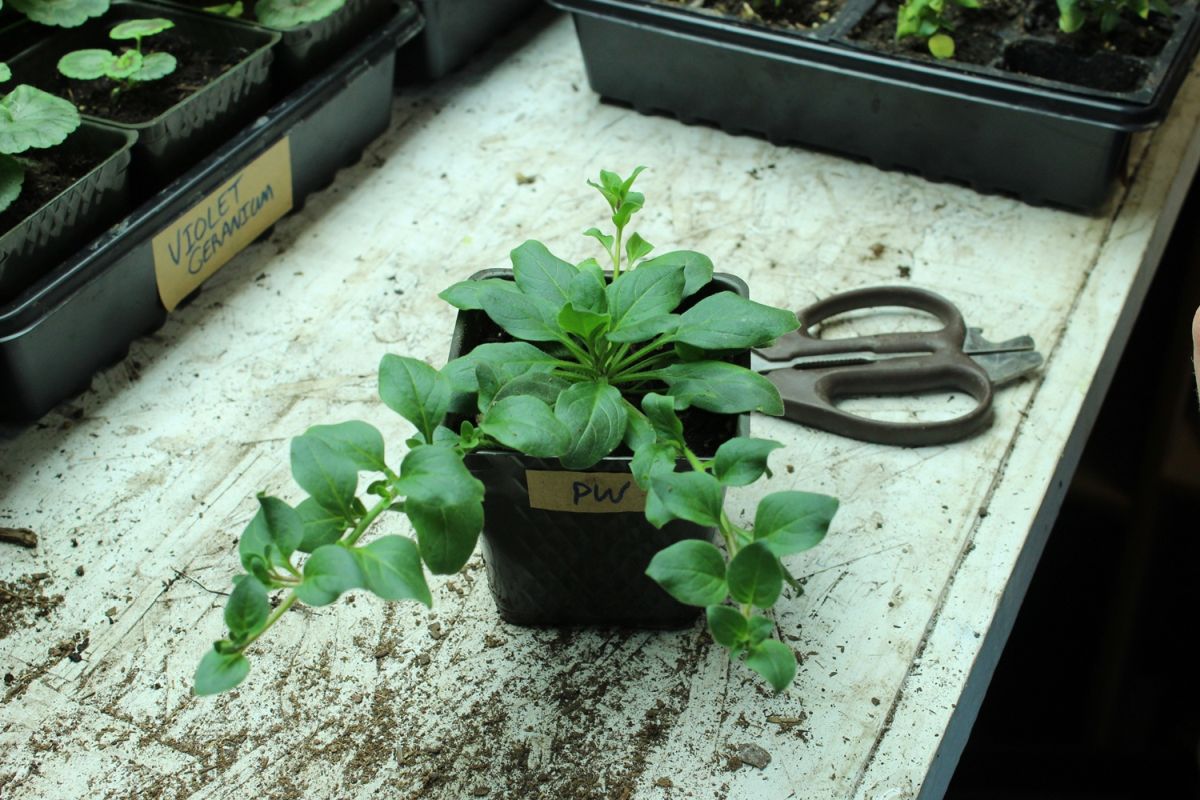
This purple wave petunia is meant to be a large plant (tidal wave petunias are actually the largest in the petunia family and will reach nearly two feet tall and three to five feet wide!). So it makes sense that these will be fast-growing from their beginnings.
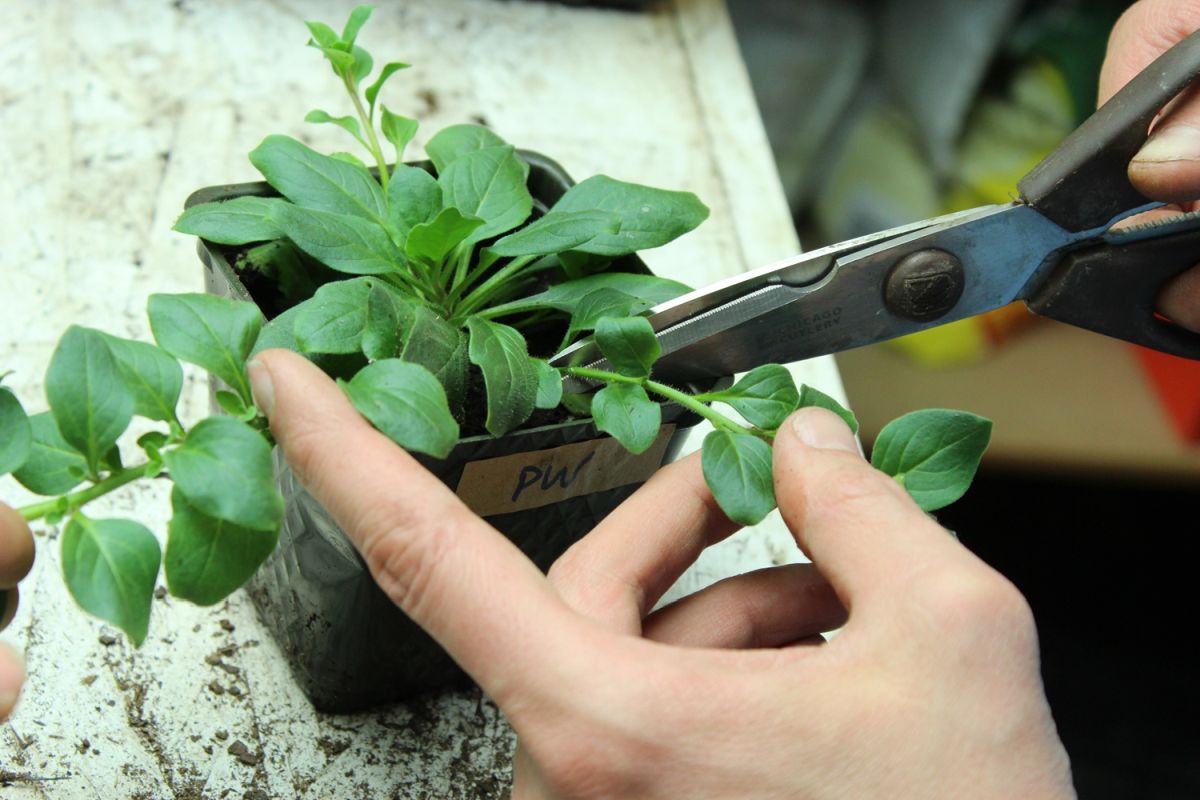
Gently pull a long vine straight outward from the plant. Cut it directly (about ¼”) after a leaf anywhere along the vine; we recommend clipping at about the edge of the planting container. (The scissors make it hard to see, but there is a leaf coming out of the vine directly behind the scissors, making this an excellent cutting point.)

Continue all around the petunia plant with any long vines. You can even clip the main stem if it’s starting to get too tall, following the same cut-after-the-leaf rule.
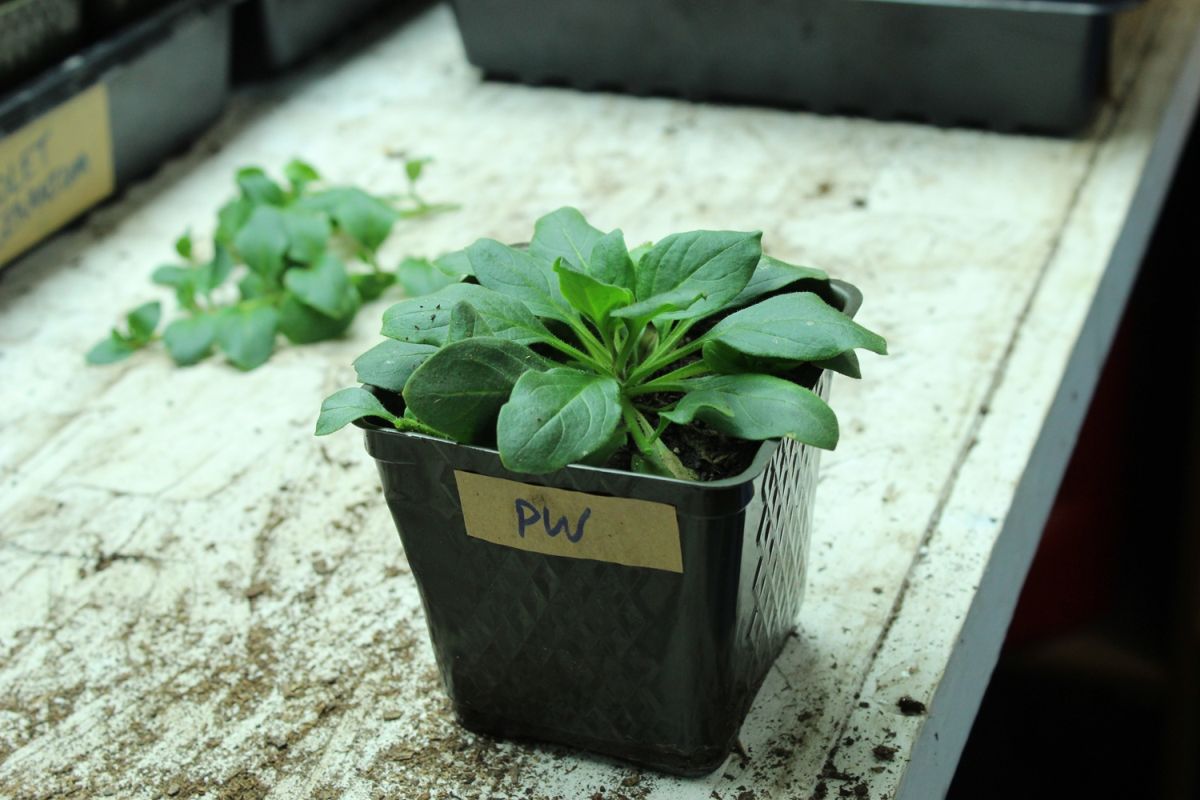
Here is that same petunia plant, just with a new and improved “haircut.” It will fit better in the tray without infringing on (or thwarting) other plants.

When you’ve trimmed your petunias and have a pile of clippings, it’s time to root and plant them. Fill some four-pack planting containers with potting soil.
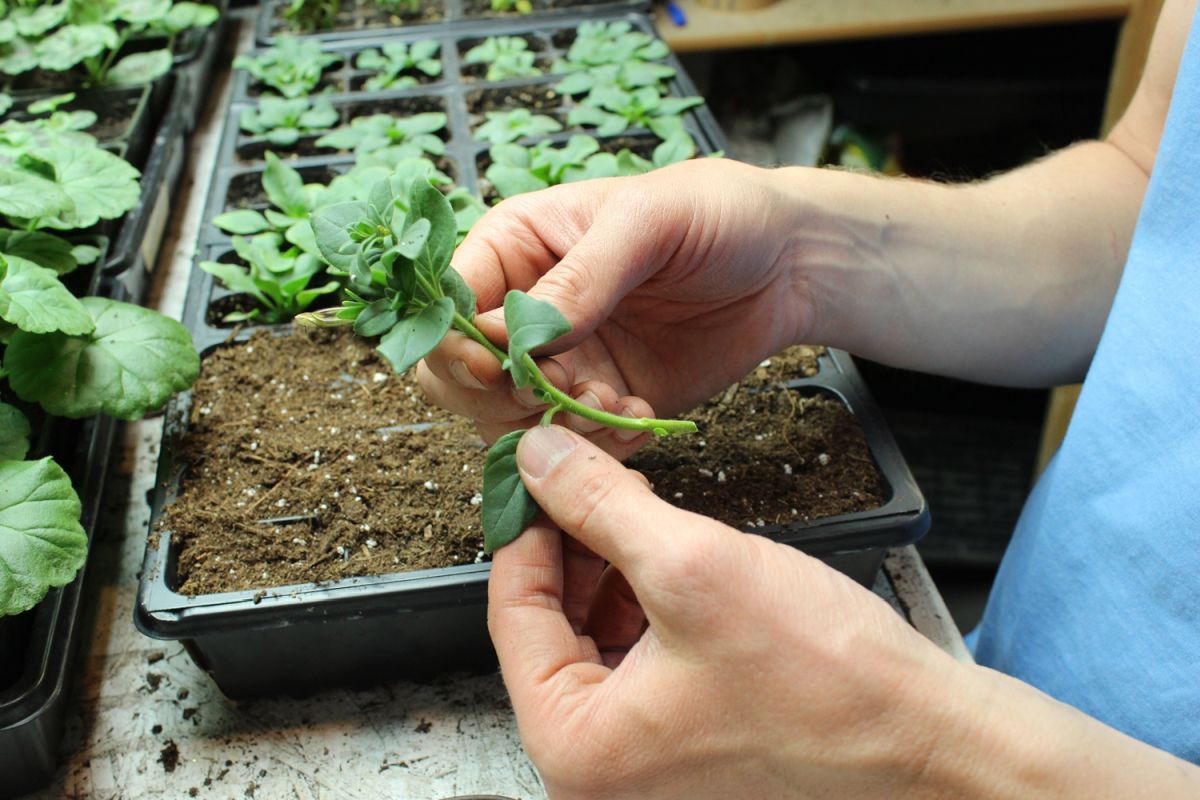
Pick a cutting from your pile that looks healthy. Pull off lower leaves up to about 1-1/2” from the cut point.
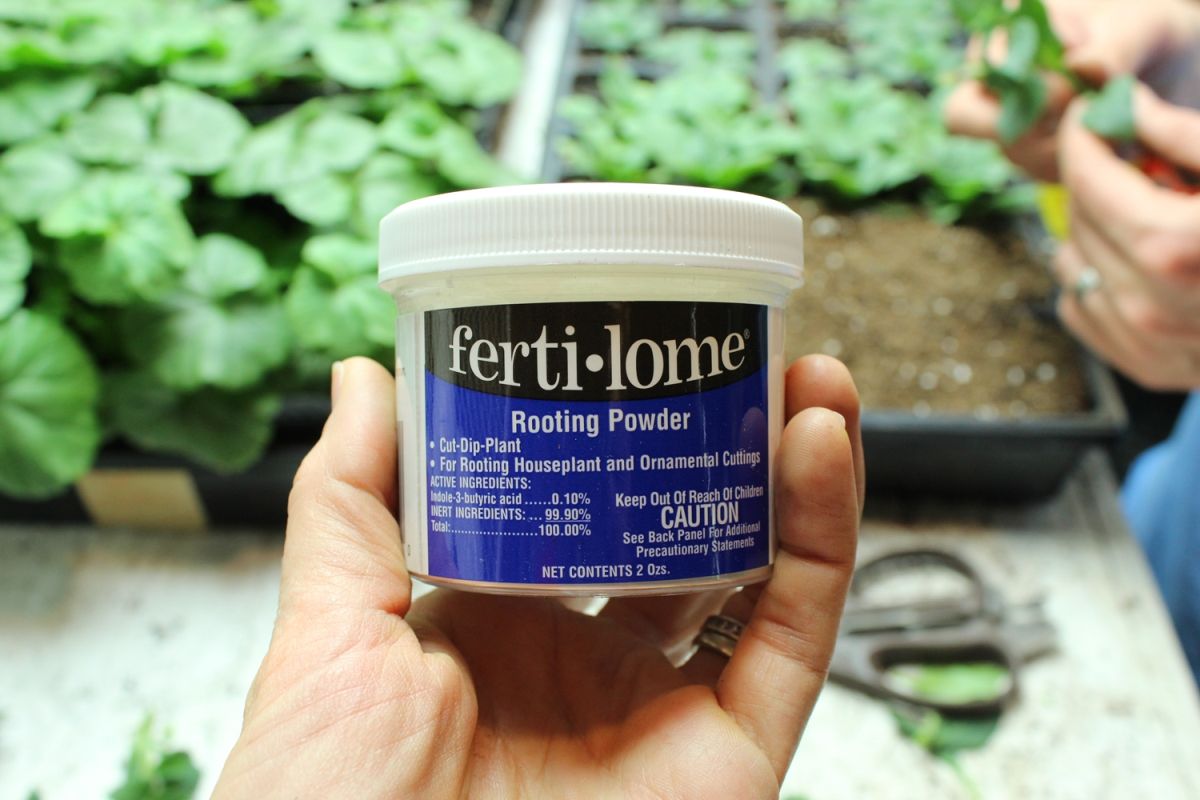
To make this transplant successful, you’ll want to utilize some rooting powder. This expedites the stem’s ability to develop roots – their quick development is key to the cuttings’ survival. Without roots, your cutting won’t be able to take in sufficient water to survive.
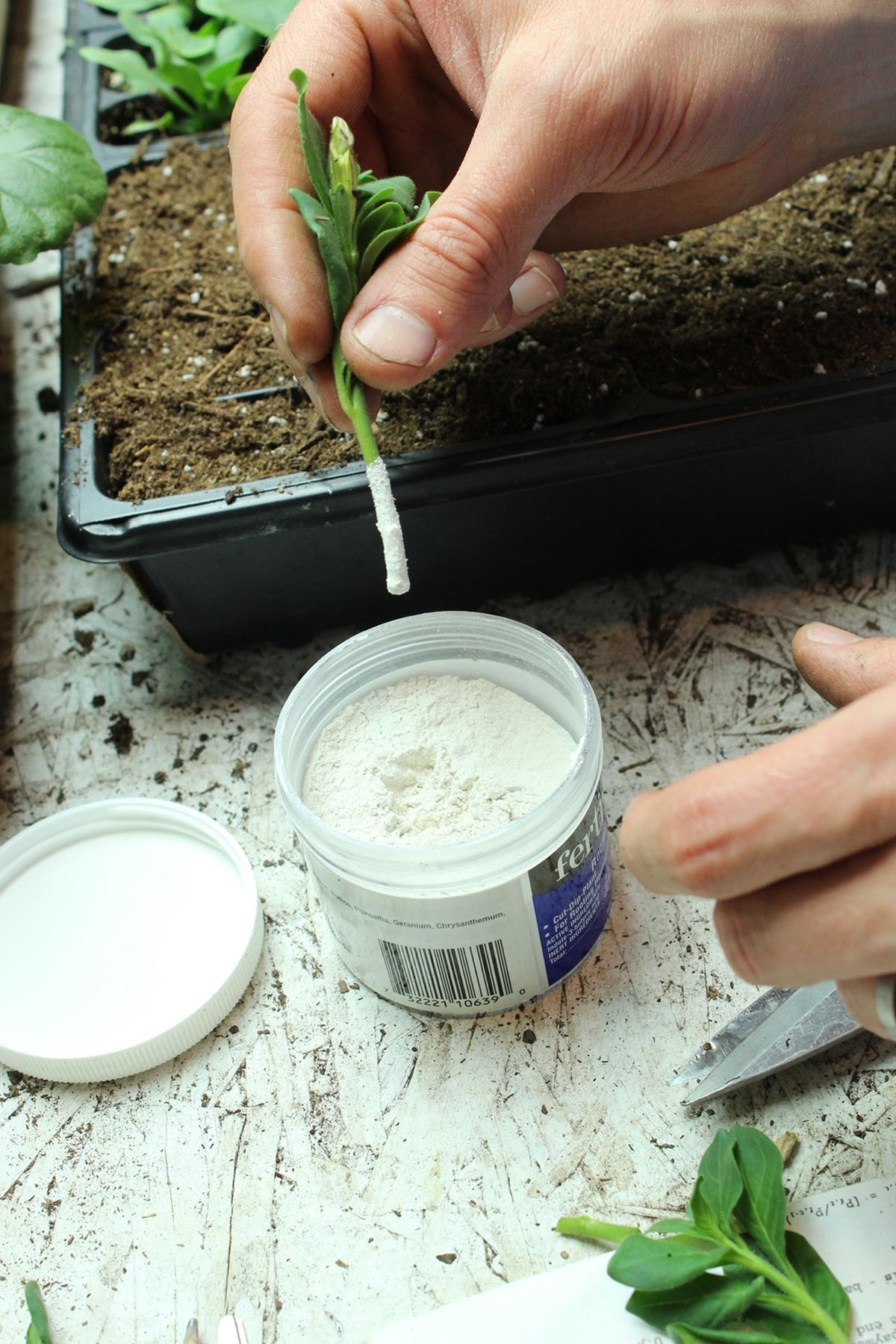
Dip the lower 1” to 1-1/2” of your cutting into the rooting powder.
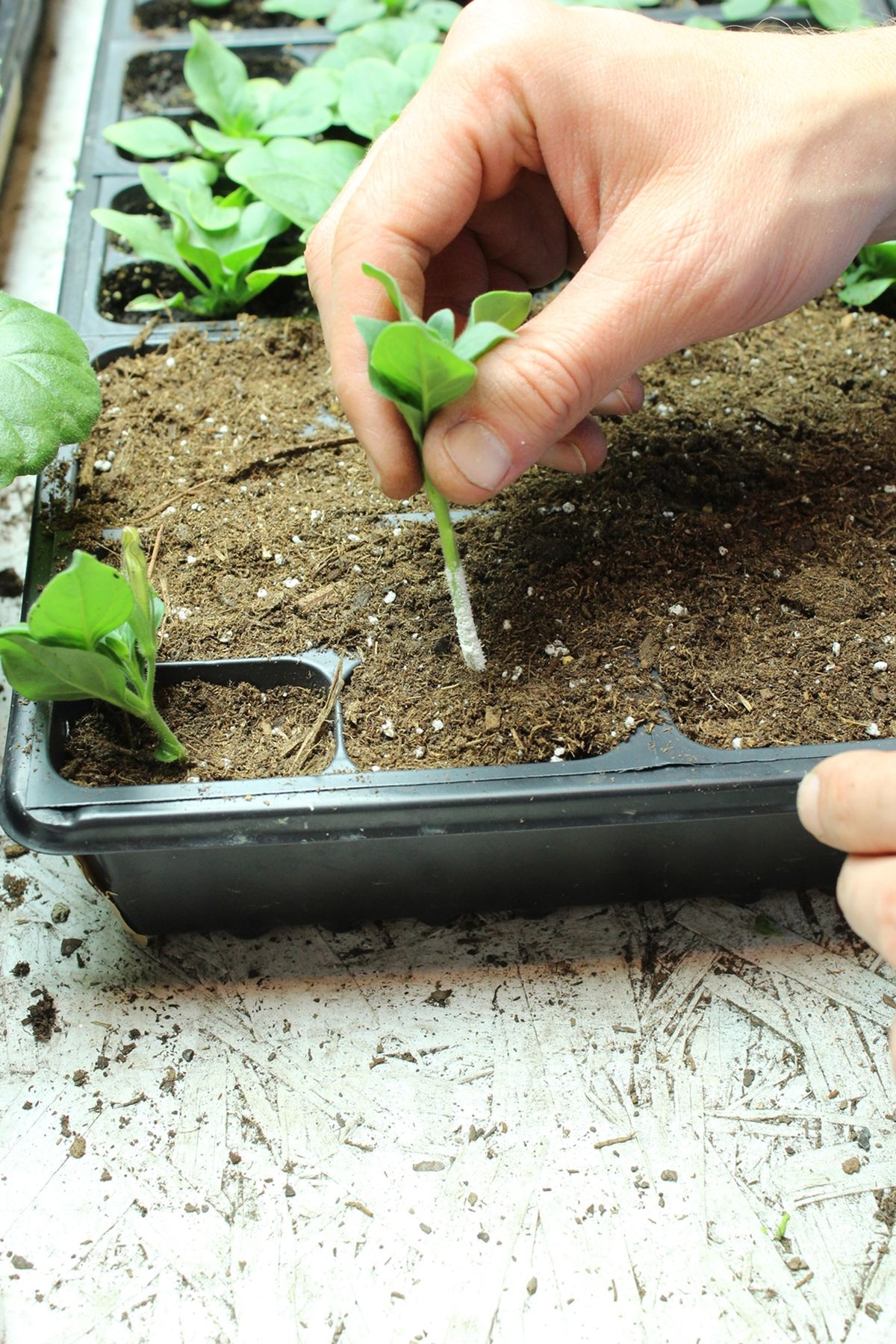
Slide the cutting into one of the four-pack soil spots.
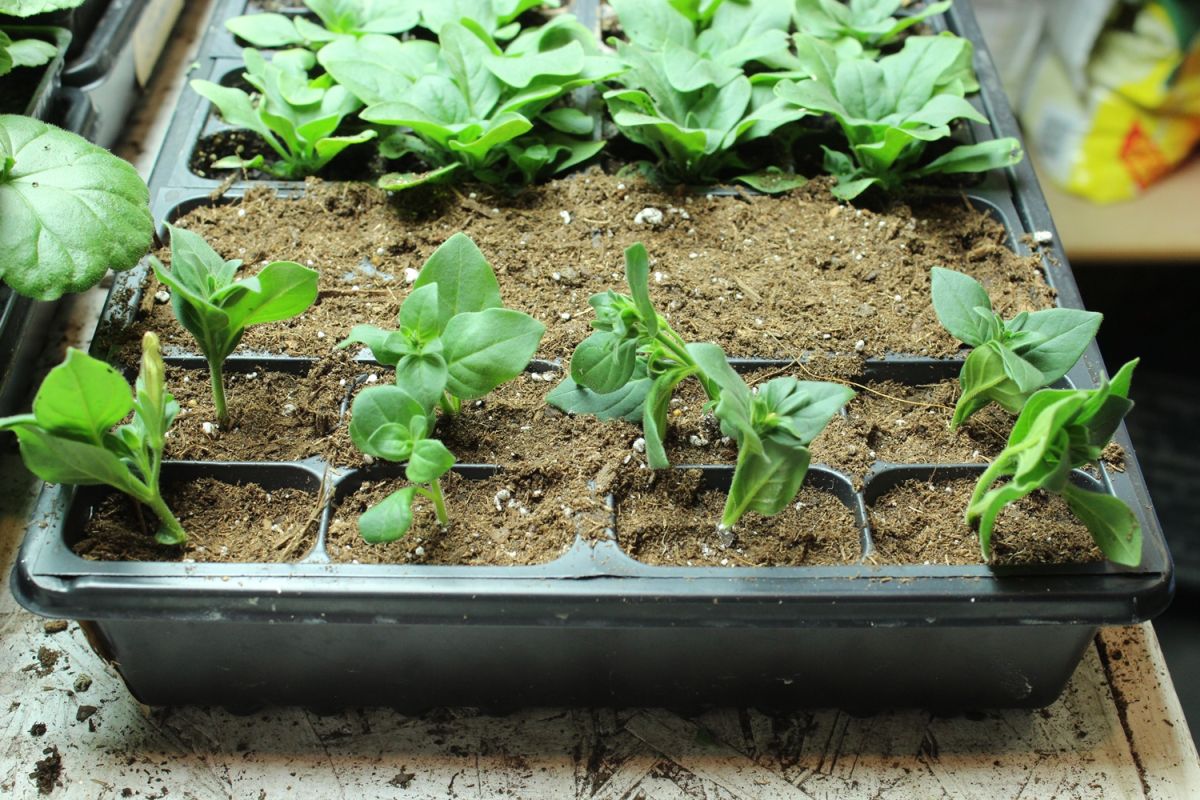
Repeat this process for each of your cuttings until your four-packs are filled to your satisfaction.

As with any transplant, you’ll want to give the newly planted cuttings a healthy drink of water.
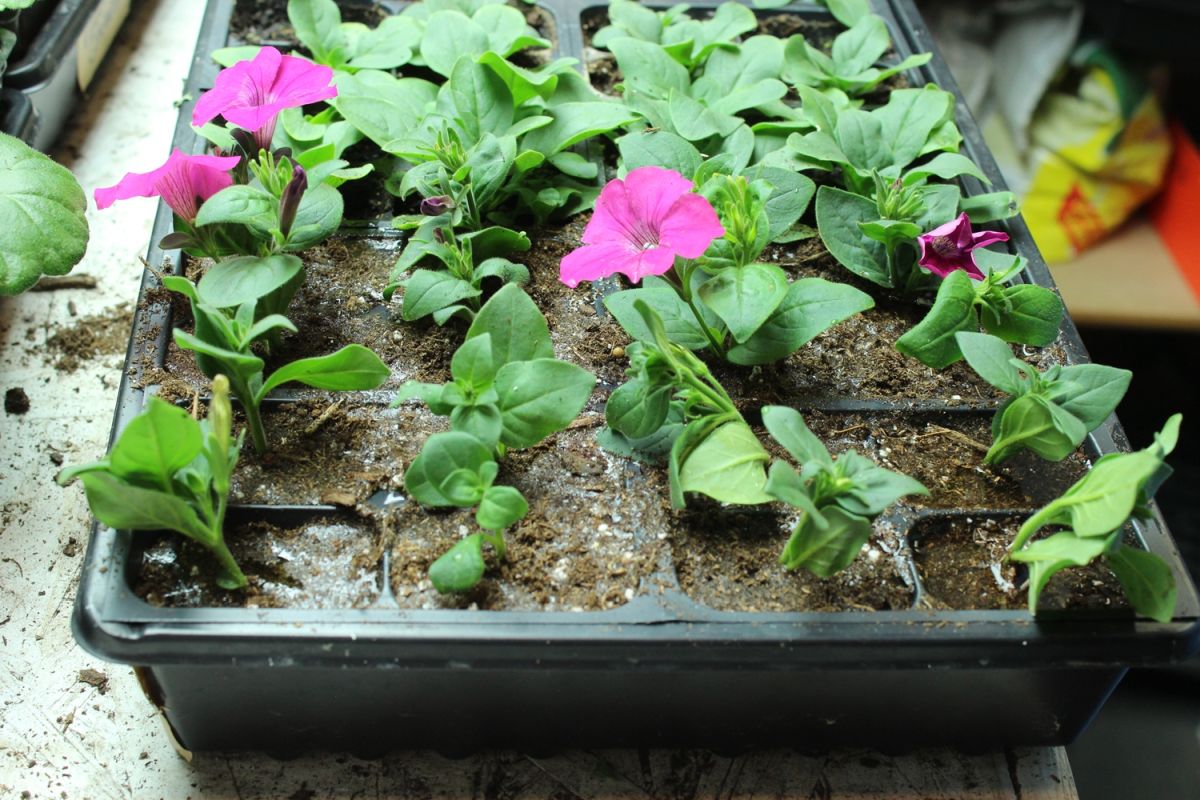
Continue caring for the cuttings as you would your other plants – plenty of light under your grow lights (if it’s still too early to be planted outside) and daily water for moist, but not soggy, soil.
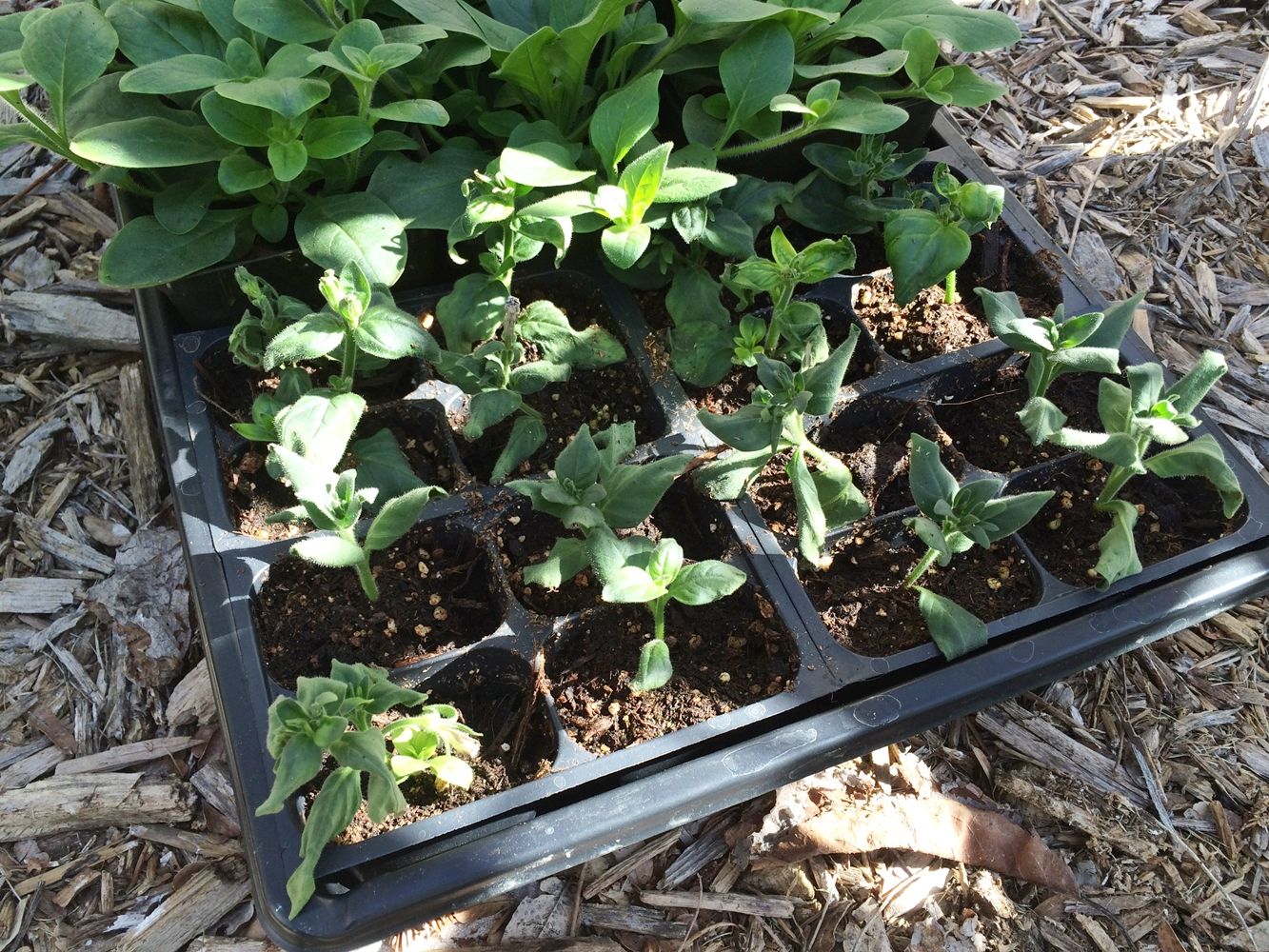
Don’t be discouraged if the leaves look somewhat limp for a couple of days. This isn’t an indication that the cuttings didn’t “take,” it simply is a natural consequence of having no (or limited) roots. They’ll come around.
Hardening Your Plants Before Planting Outside
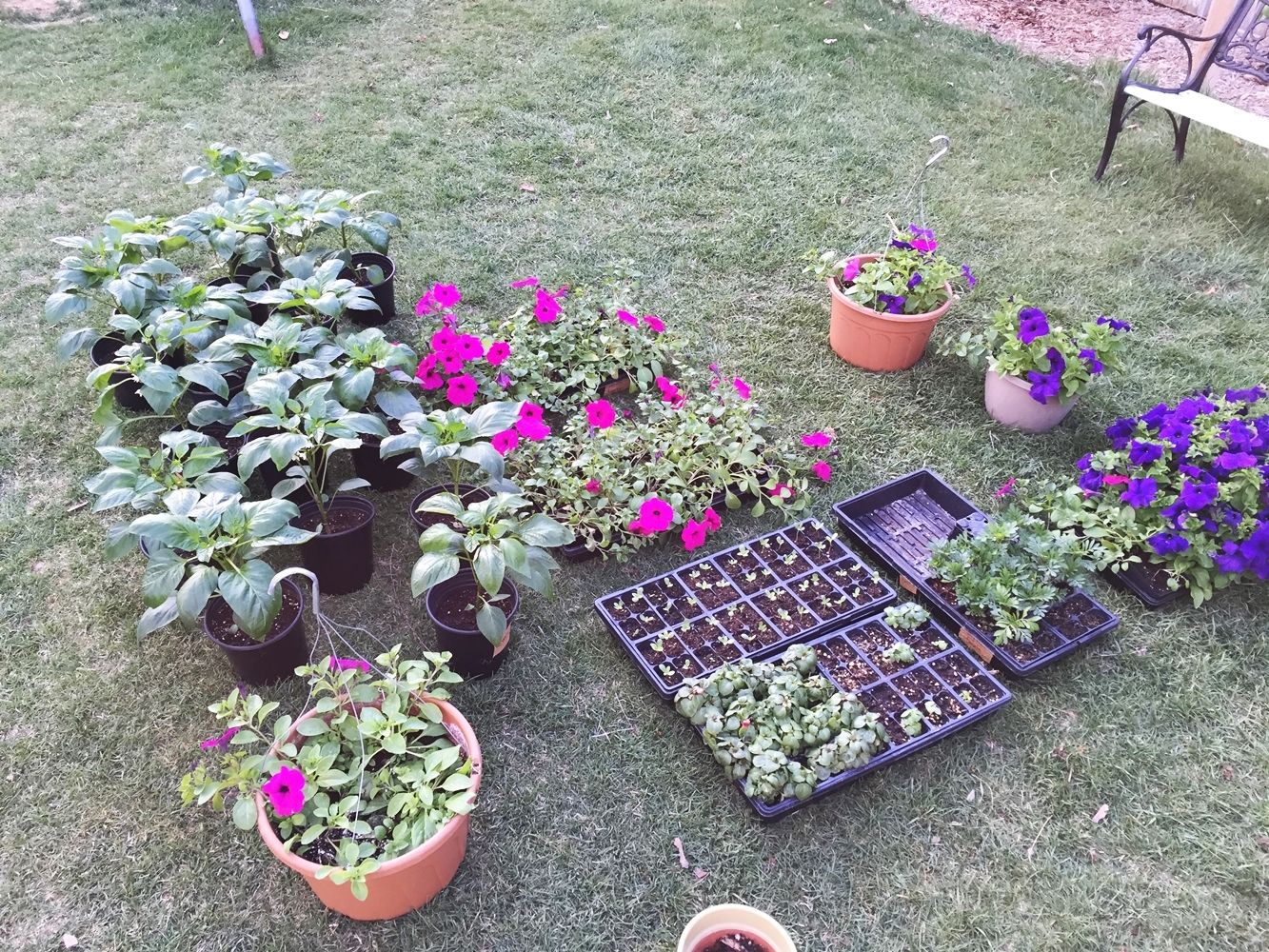
Continue watering and lighting your starts daily. When weather starts warming up, it’s time to begin the hardening process. This is critical, if you’re planning on planting your flowers outside. If you take a thriving greenhouse-grown plant and plant it outside without hardening, the chances of its survival are slim, even in glorious weather conditions. Plants should be acclimated to the outdoors, just as climbers need to acclimate as they ascend high-elevation peaks.
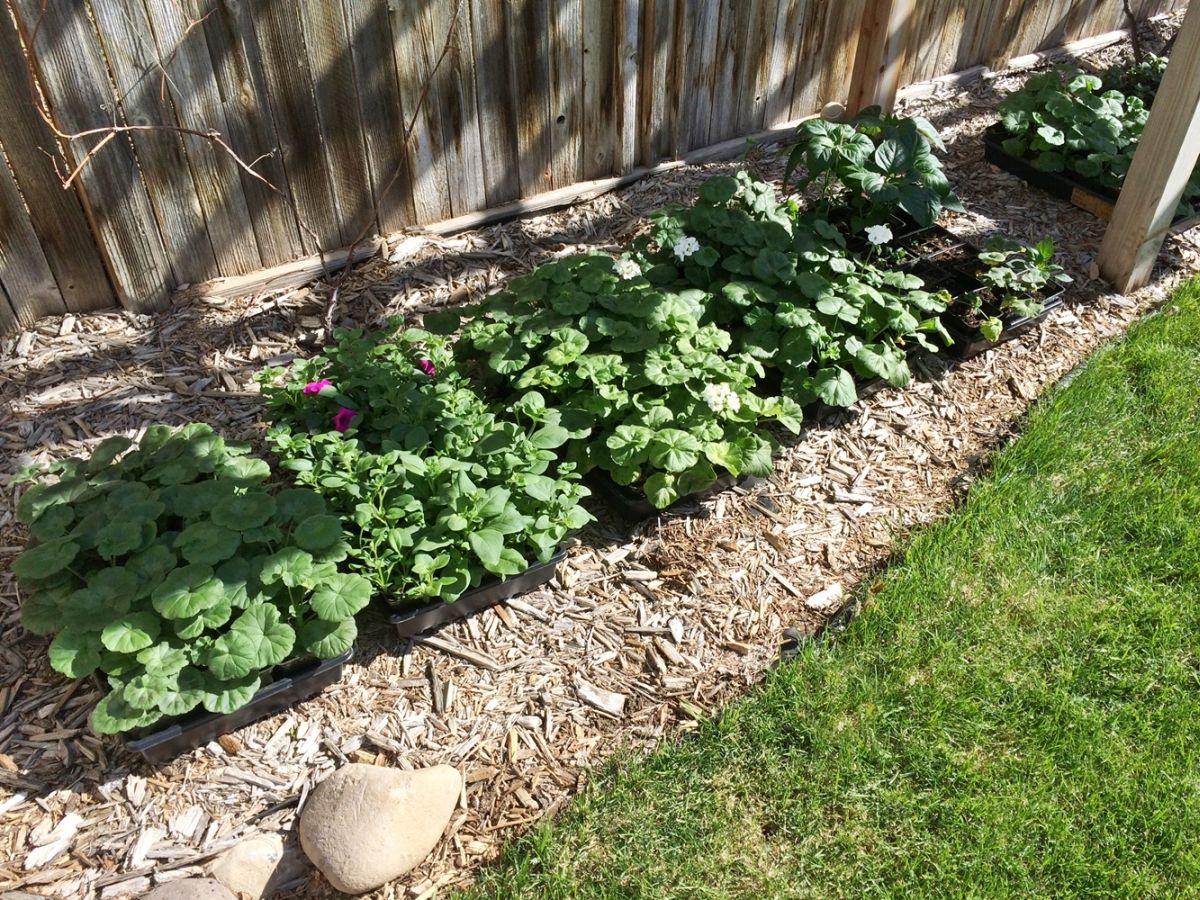
On a warm spring day, set your early starts outside for about 15-30 minutes in the shady sunlight. Then tote them back into your greenhouse. As long as the weather stays warm, you’ll want to try to do this every day, increasing their outside stints by 10-15 minute intervals each day. If they seem particularly shocked after a day of their outside time, take it easy on them the next day.
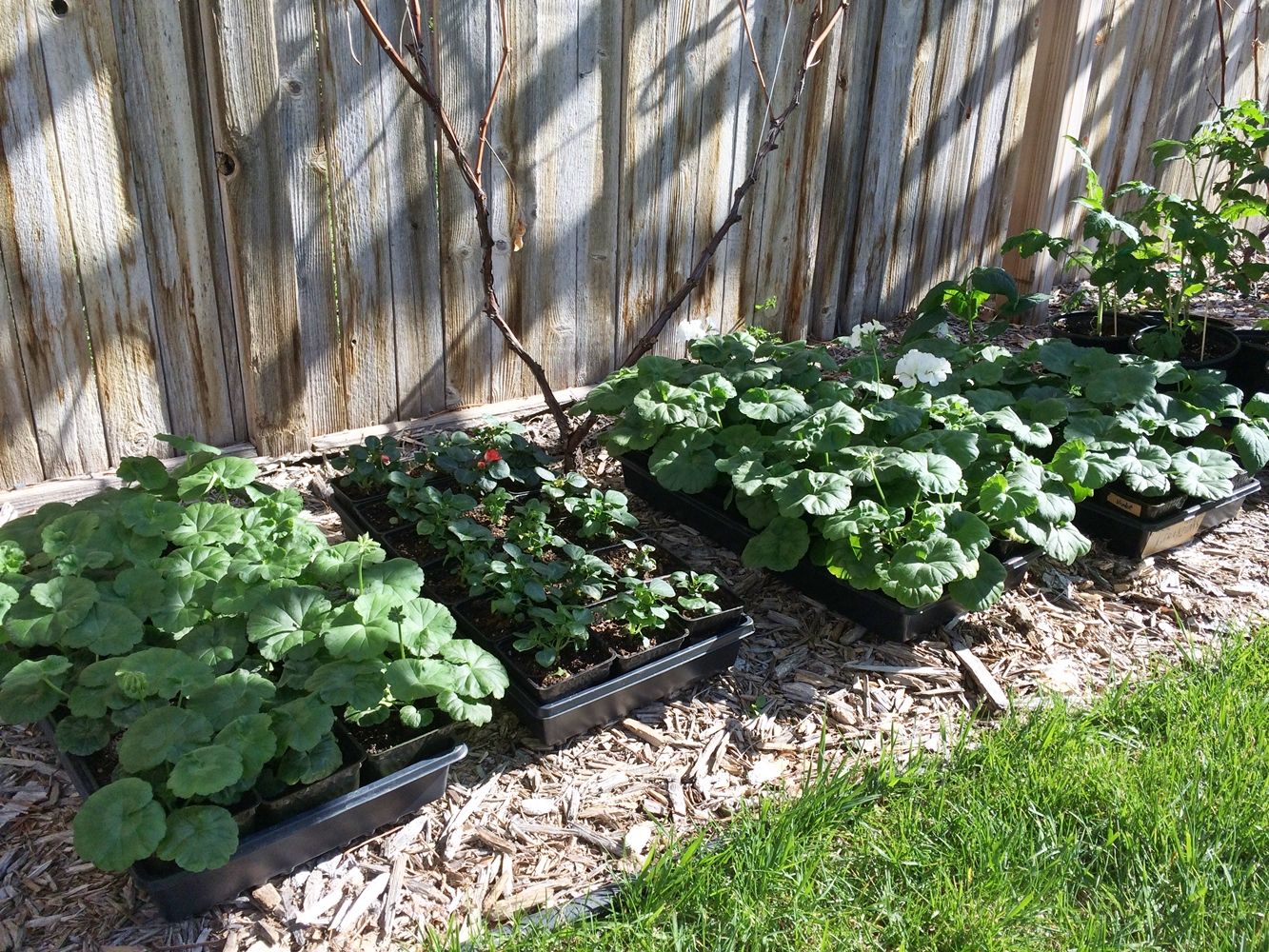
The point is to go slow and steady, gradually (that’s the key – gradually) getting them used to the great outdoors.
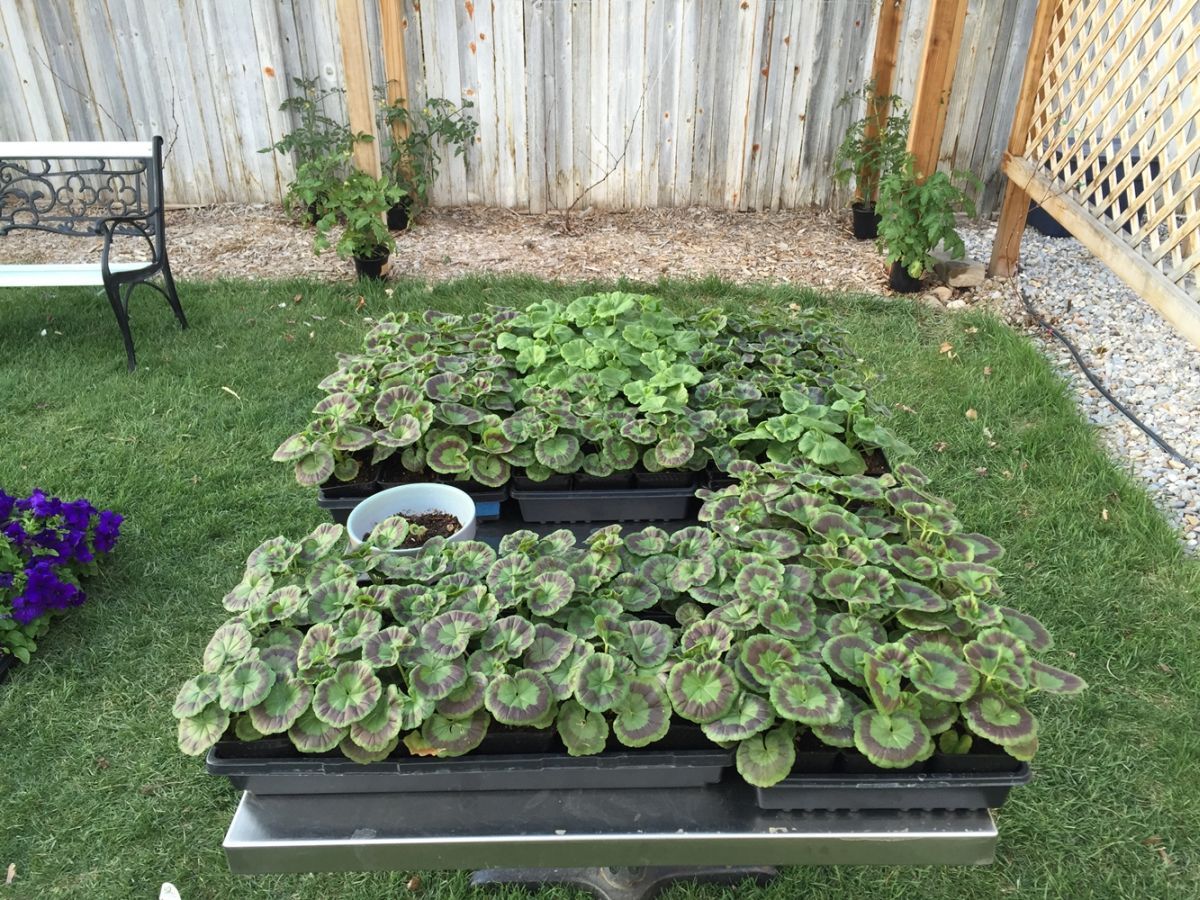
When weather is warmer and the plants seem to handle their outside time well, you can leave them outside all day, sunrise to sunset, and see how that goes. When they’ve handled that well for a while, and the weather stays nice, you can try leaving them outside overnight.
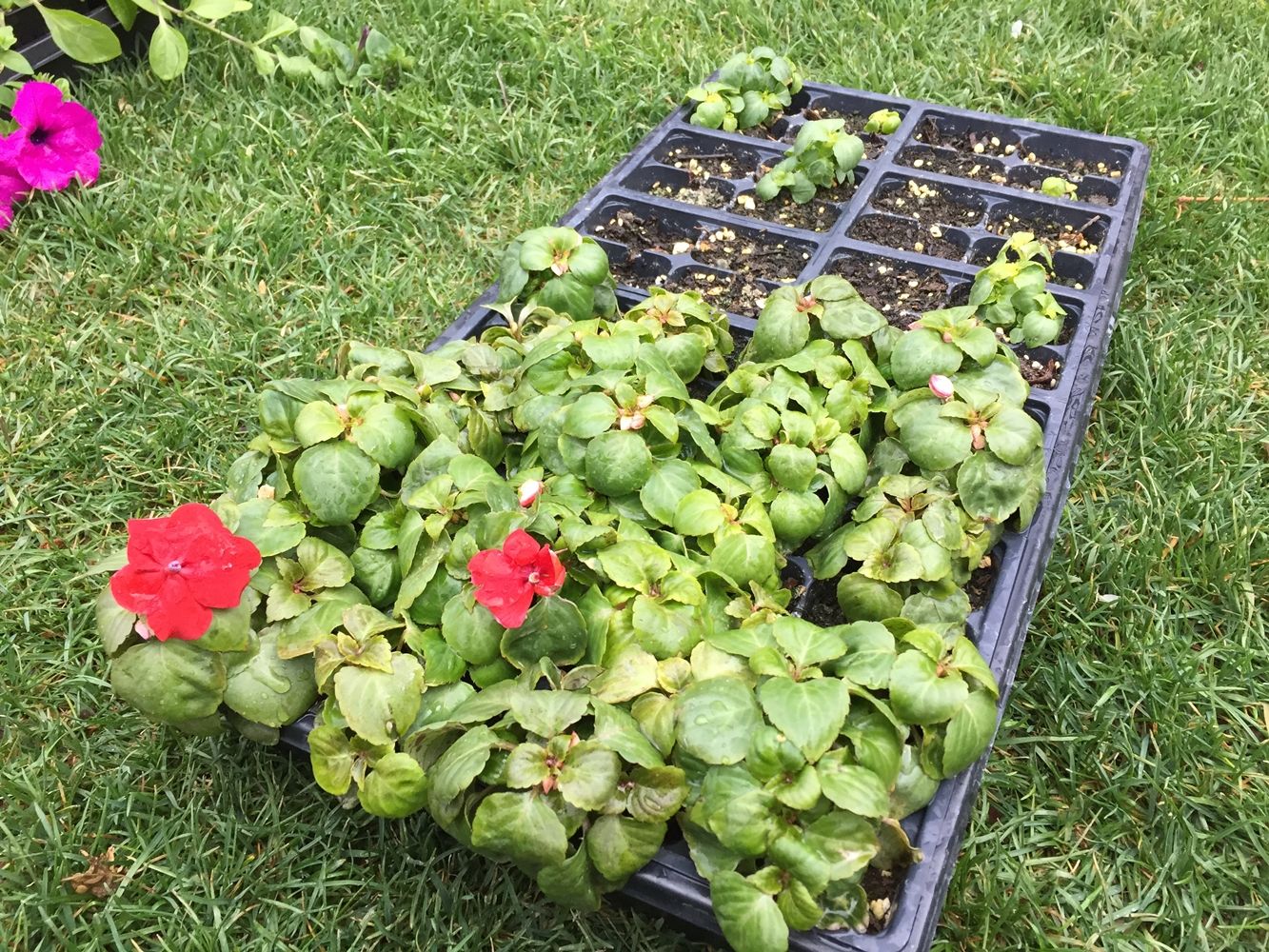
Be sure to check the temperatures, though, to make sure they don’t dip too low. Just one night of freezing temps could kill your months of hard work.

Several weeks, or even a couple of months, of this hardening process will prepare your early starts beautifully for life outside the greenhouse. Sooner than you know, they’ll be ready for putting outside for the summer. Possibilities are limitless.
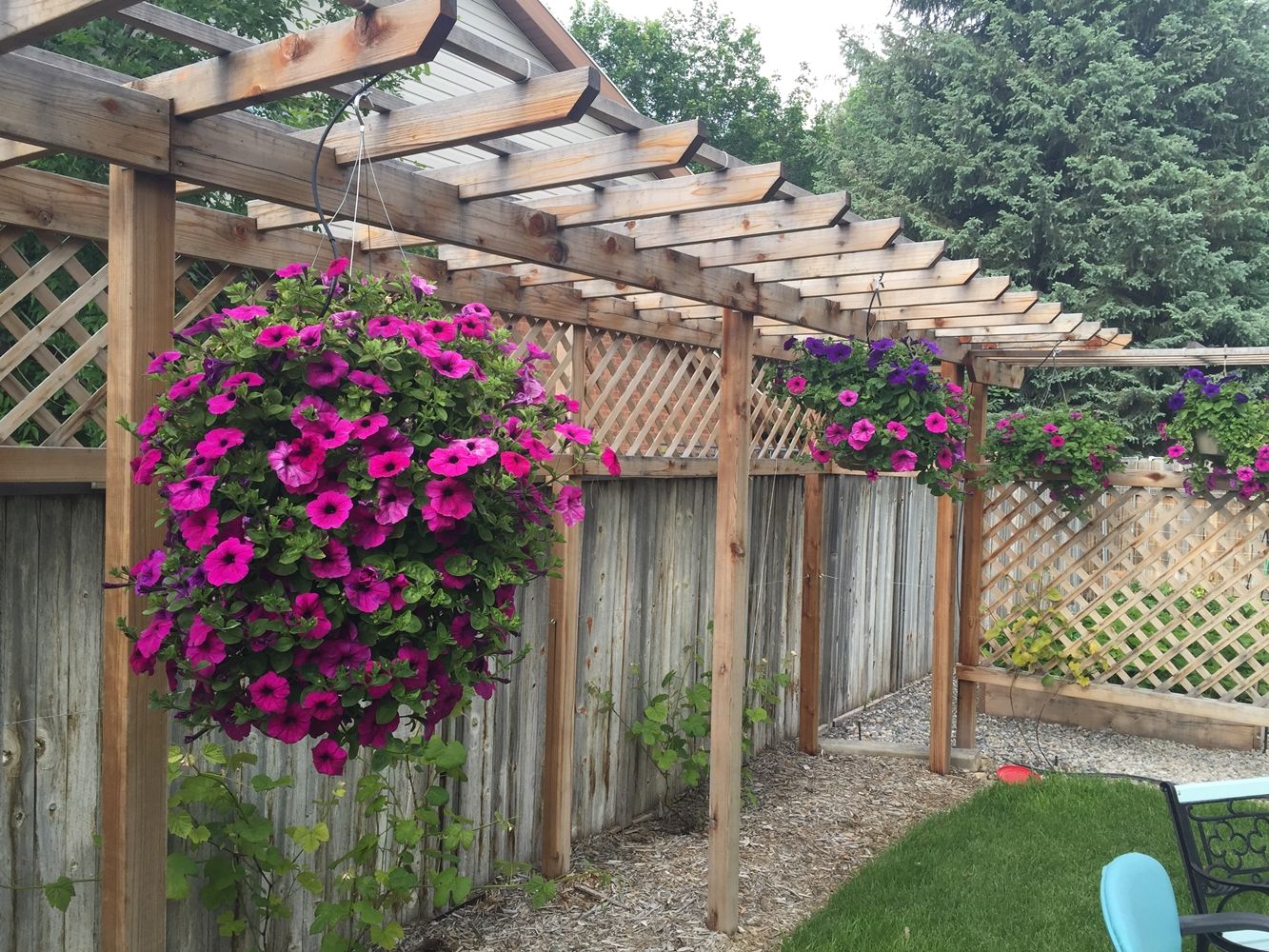
You can plant them into a hanging basket (or two or three).
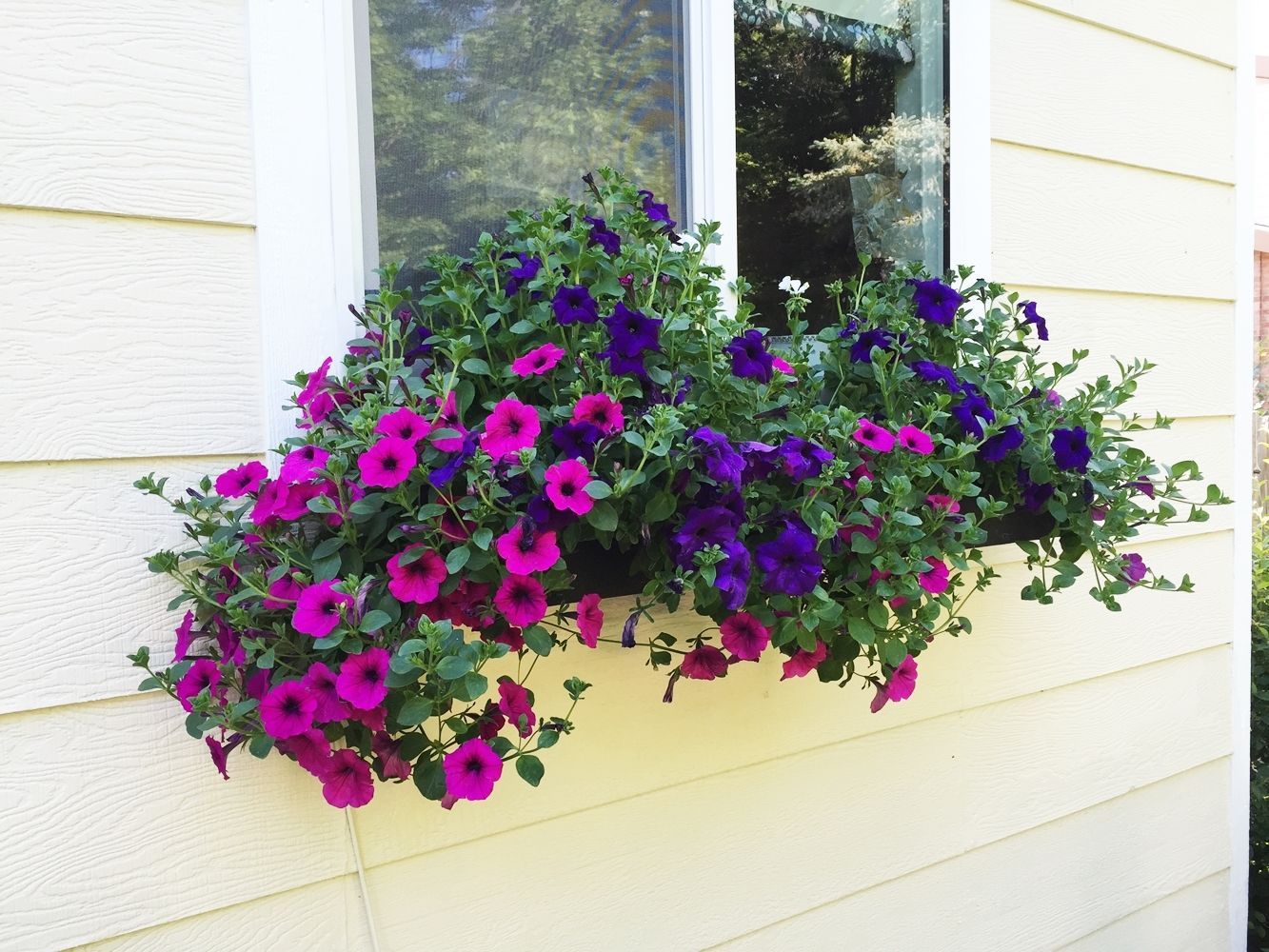
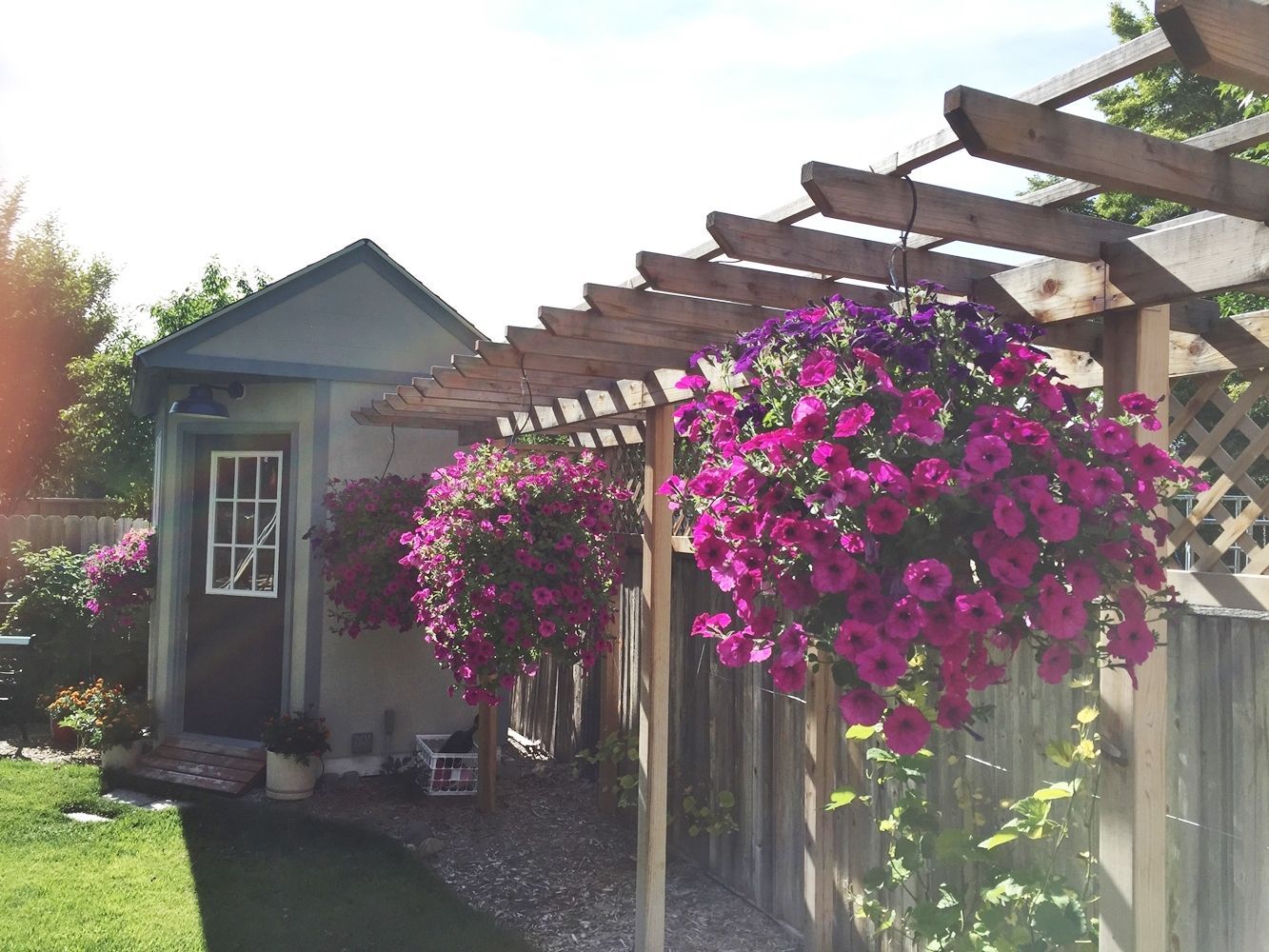
You can move them to a window or flower box to make your yard look gorgeous.
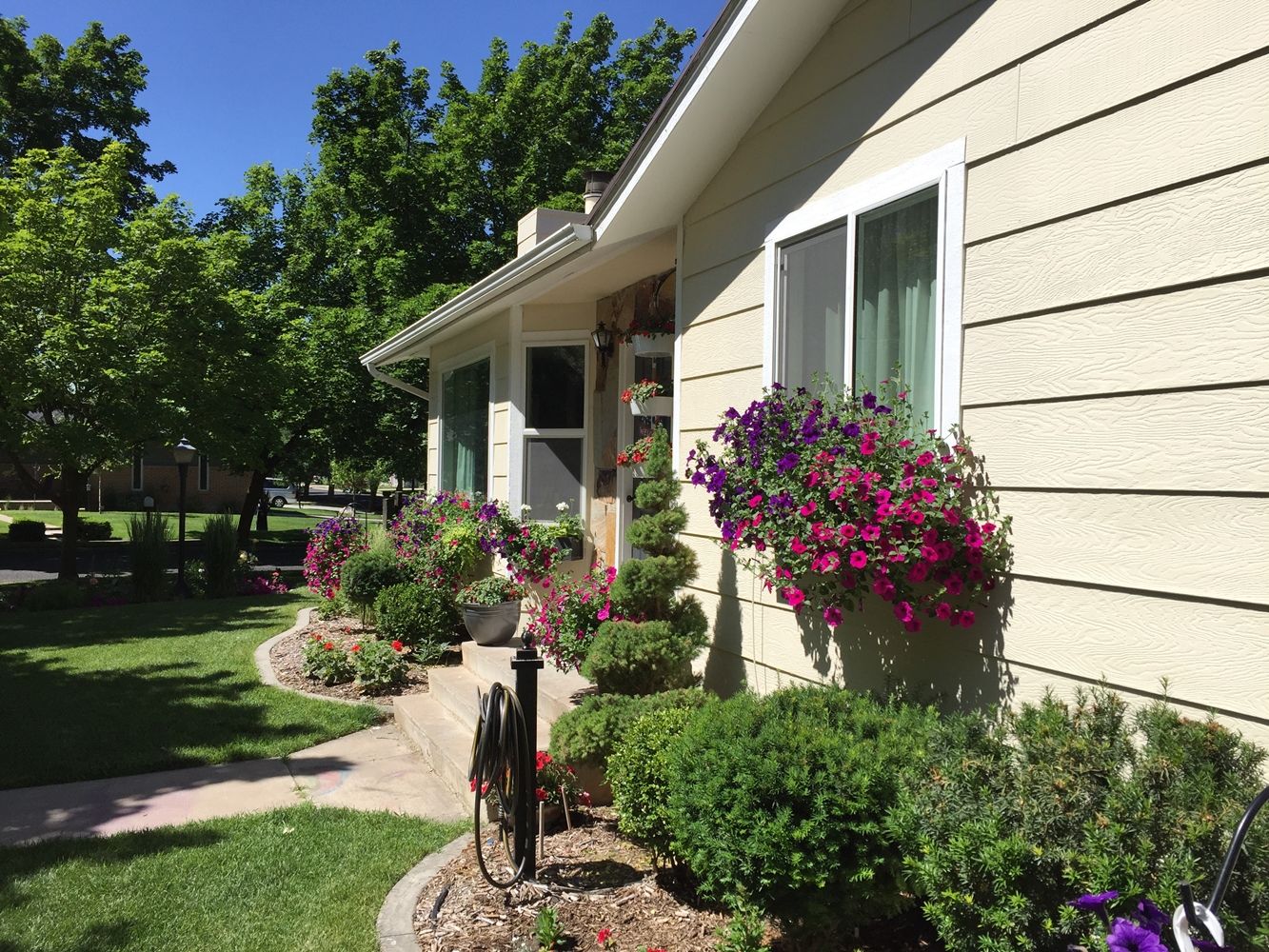
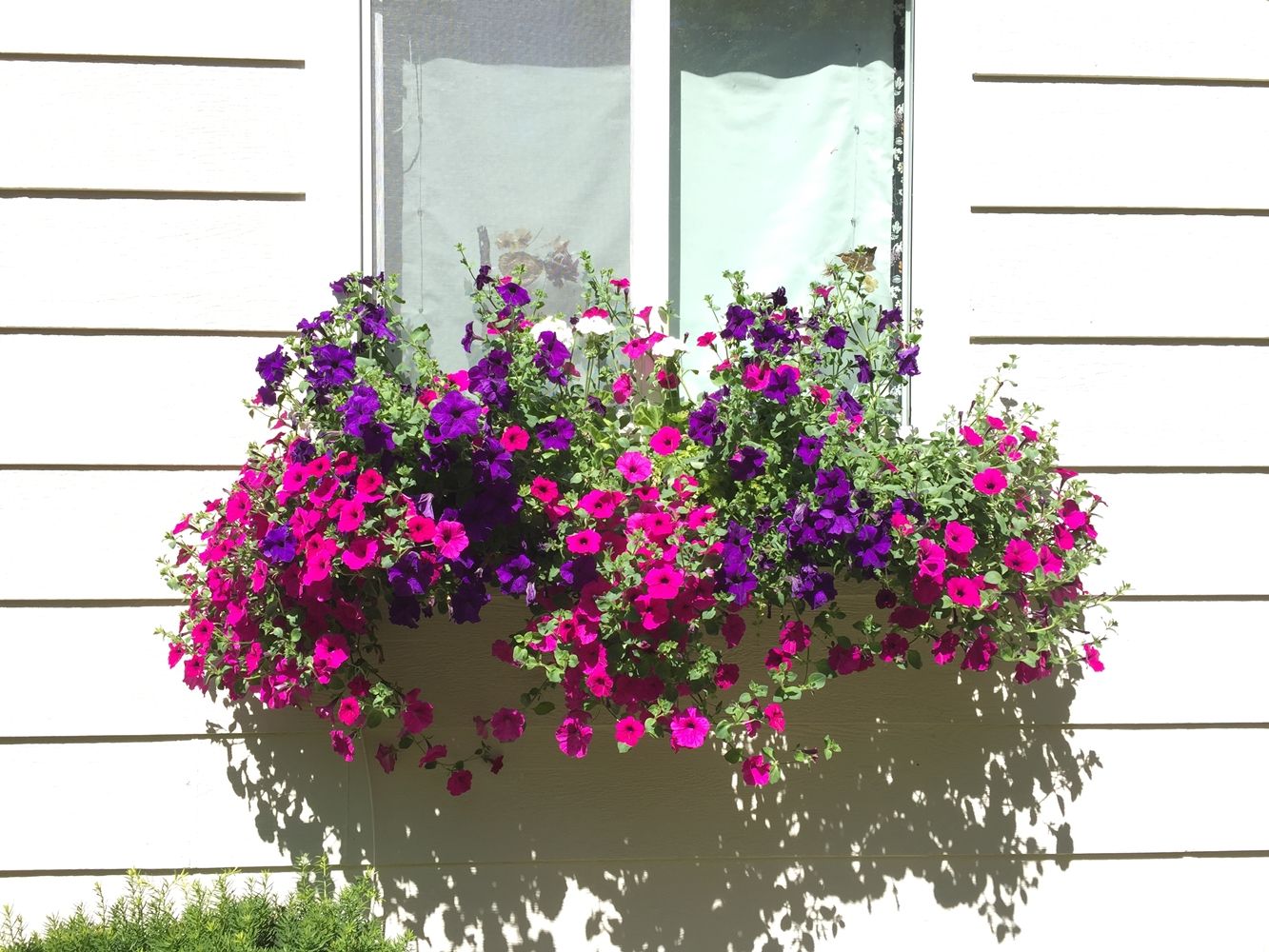
(Also, if you missed the tutorial, learn how to easily make your own window boxes.)
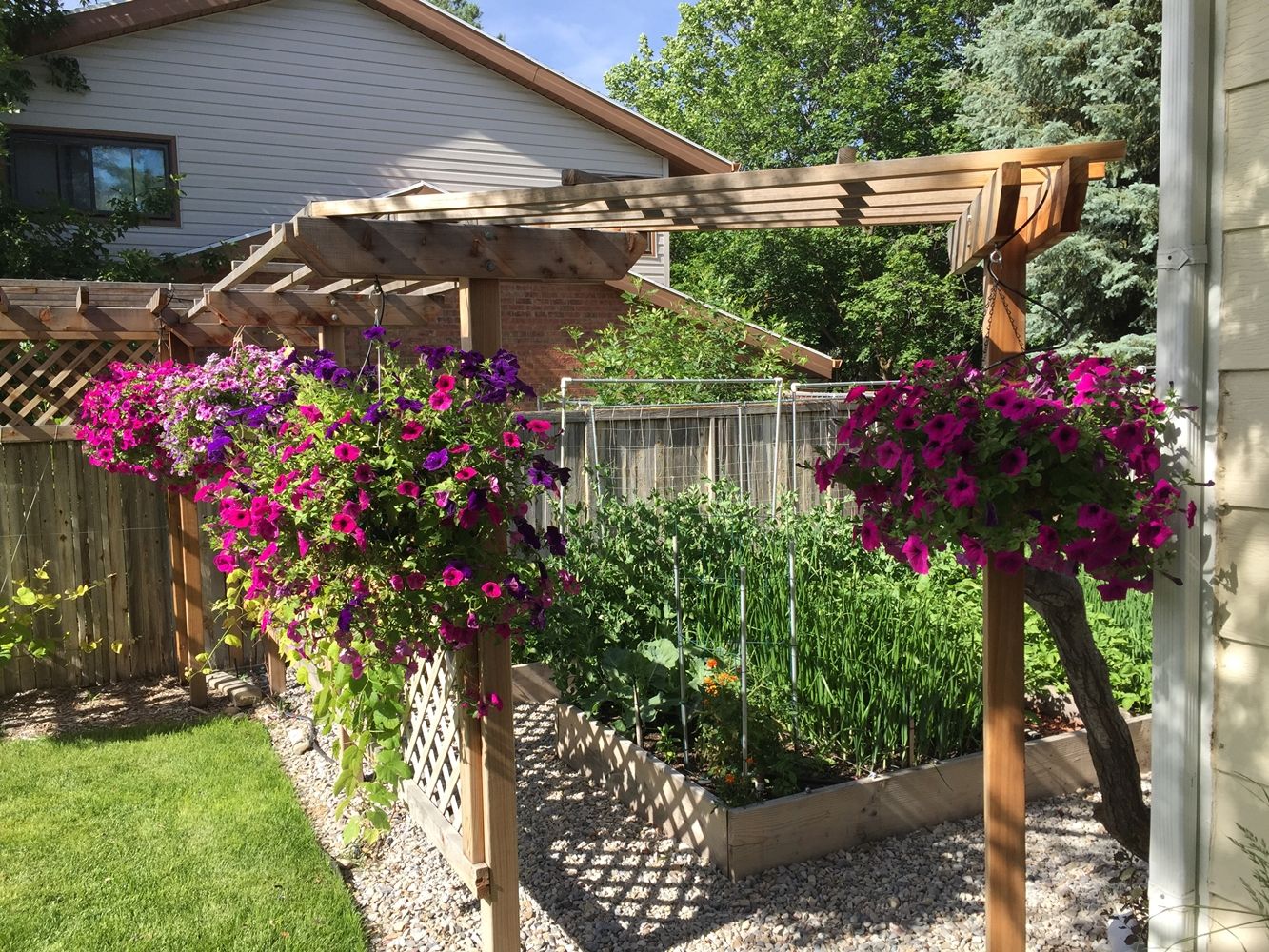
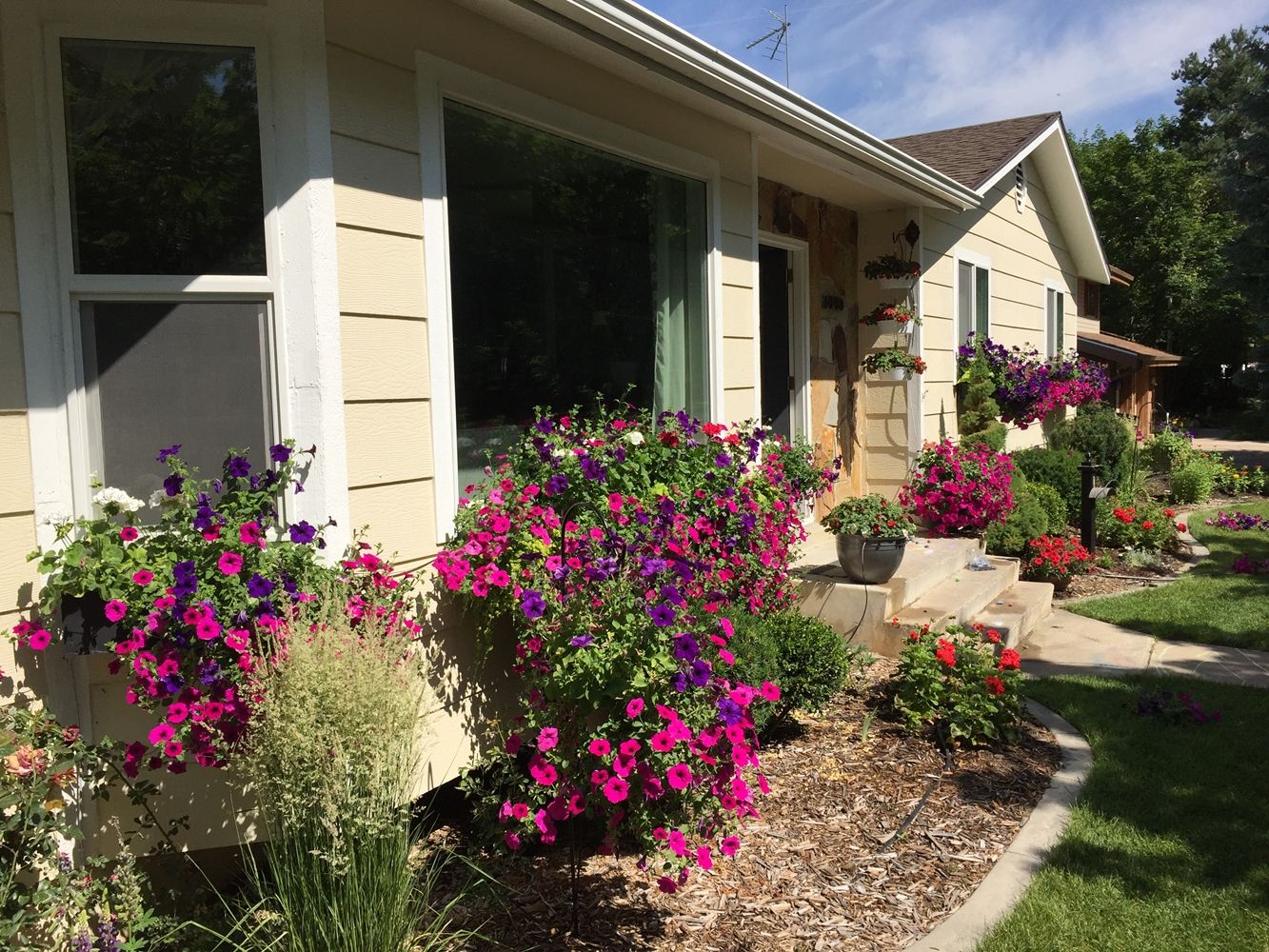
No matter how humble your home itself is or how small your acreage might be, flowers have the ability to transform it into a little slice of heaven.
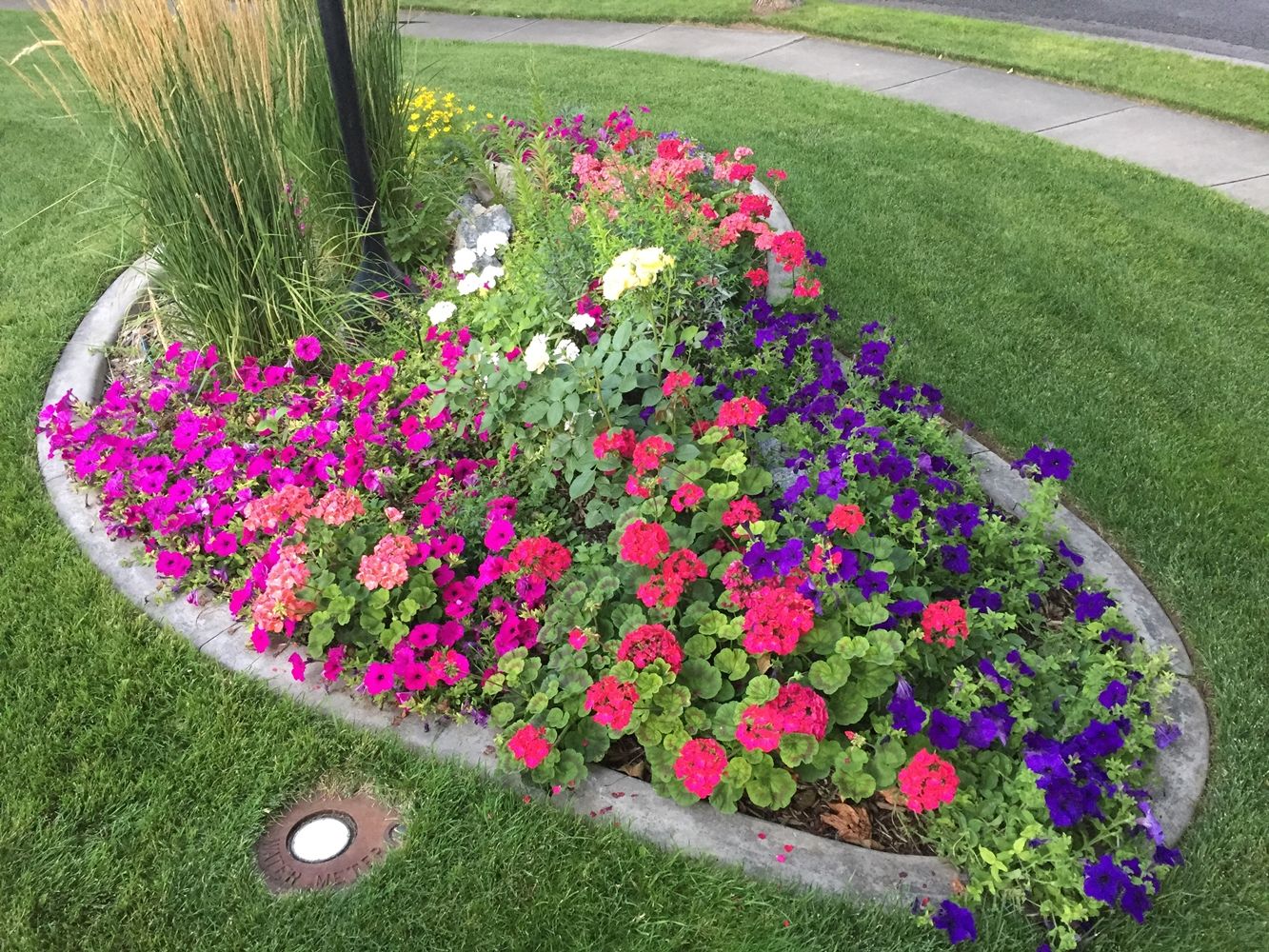
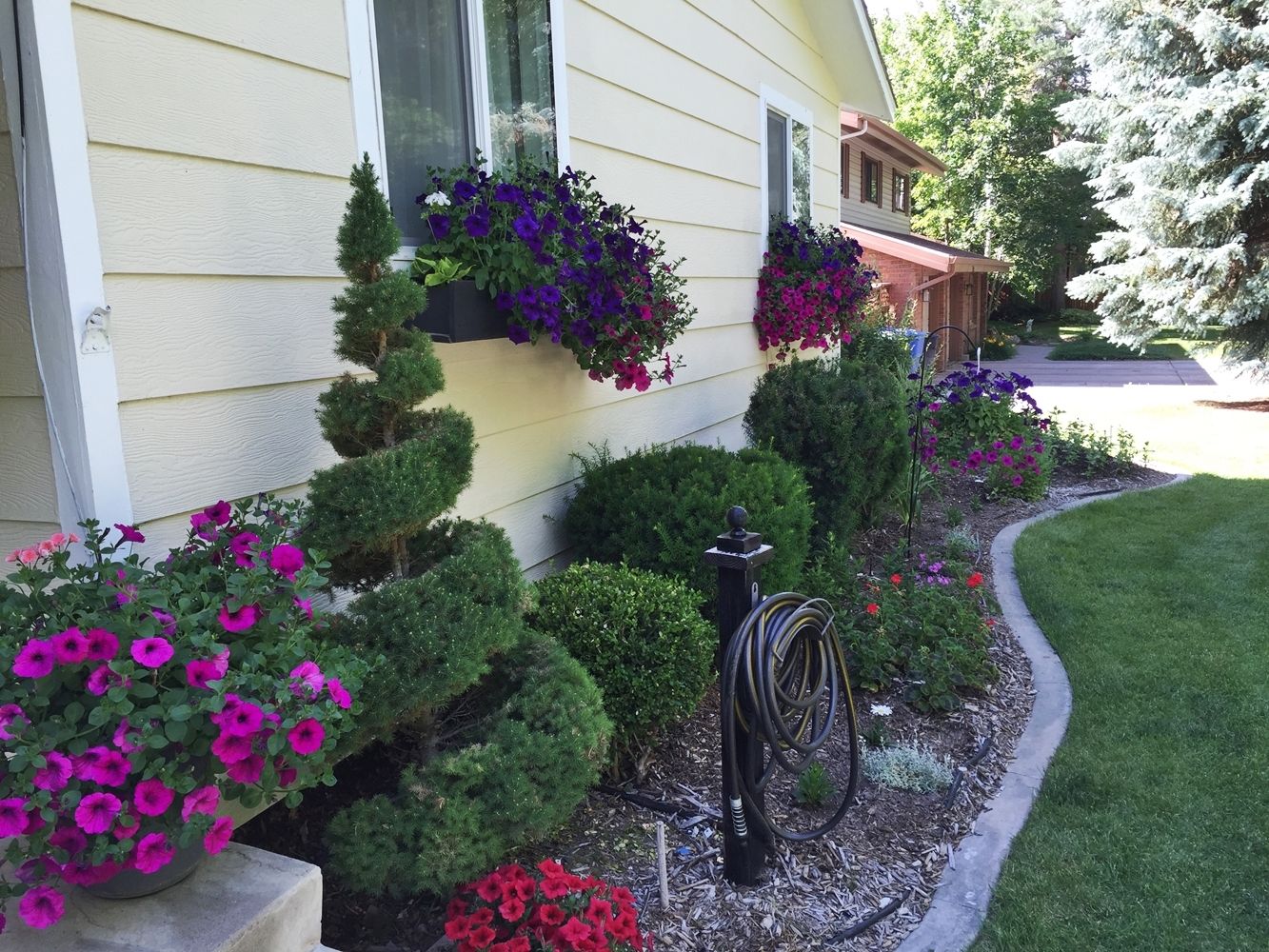
A million-dollar yard for very little cost – that’s a tradeoff most of us would be willing to make!
